Analysis of Australian Economic Data
VerifiedAdded on 2021/04/17
|23
|5465
|130
AI Summary
This assignment involves analyzing various economic data from Australia, including unemployment rates, inflation rates, and retail sales. The data is sourced from reputable institutions such as the Australian Bureau of Statistics and the Reserve Bank of Australia. The analysis provides insights into the performance of the Australian economy, highlighting trends and patterns in key economic indicators.
Contribute Materials
Your contribution can guide someone’s learning journey. Share your
documents today.
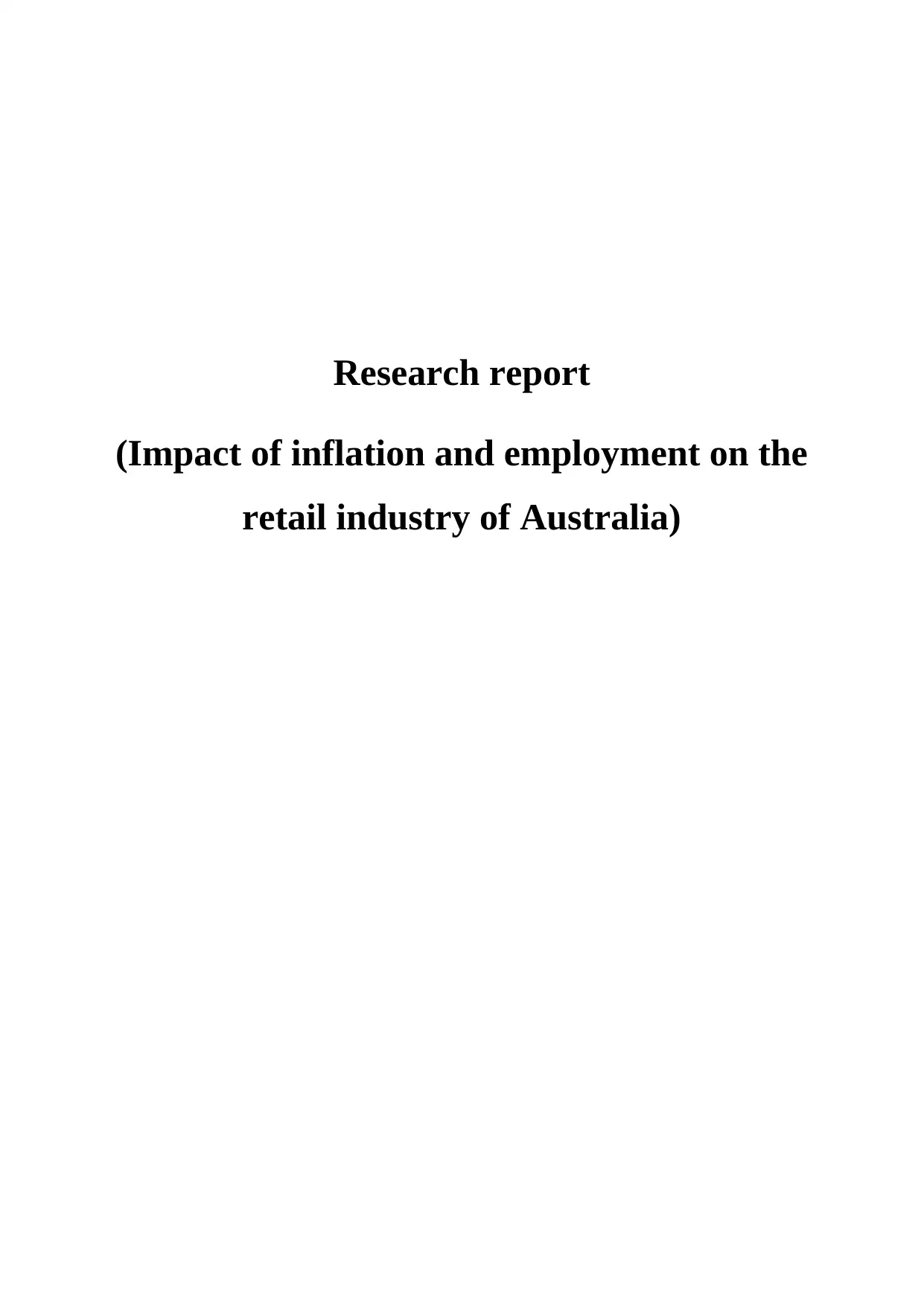
Research report
(Impact of inflation and employment on the
retail industry of Australia)
(Impact of inflation and employment on the
retail industry of Australia)
Secure Best Marks with AI Grader
Need help grading? Try our AI Grader for instant feedback on your assignments.
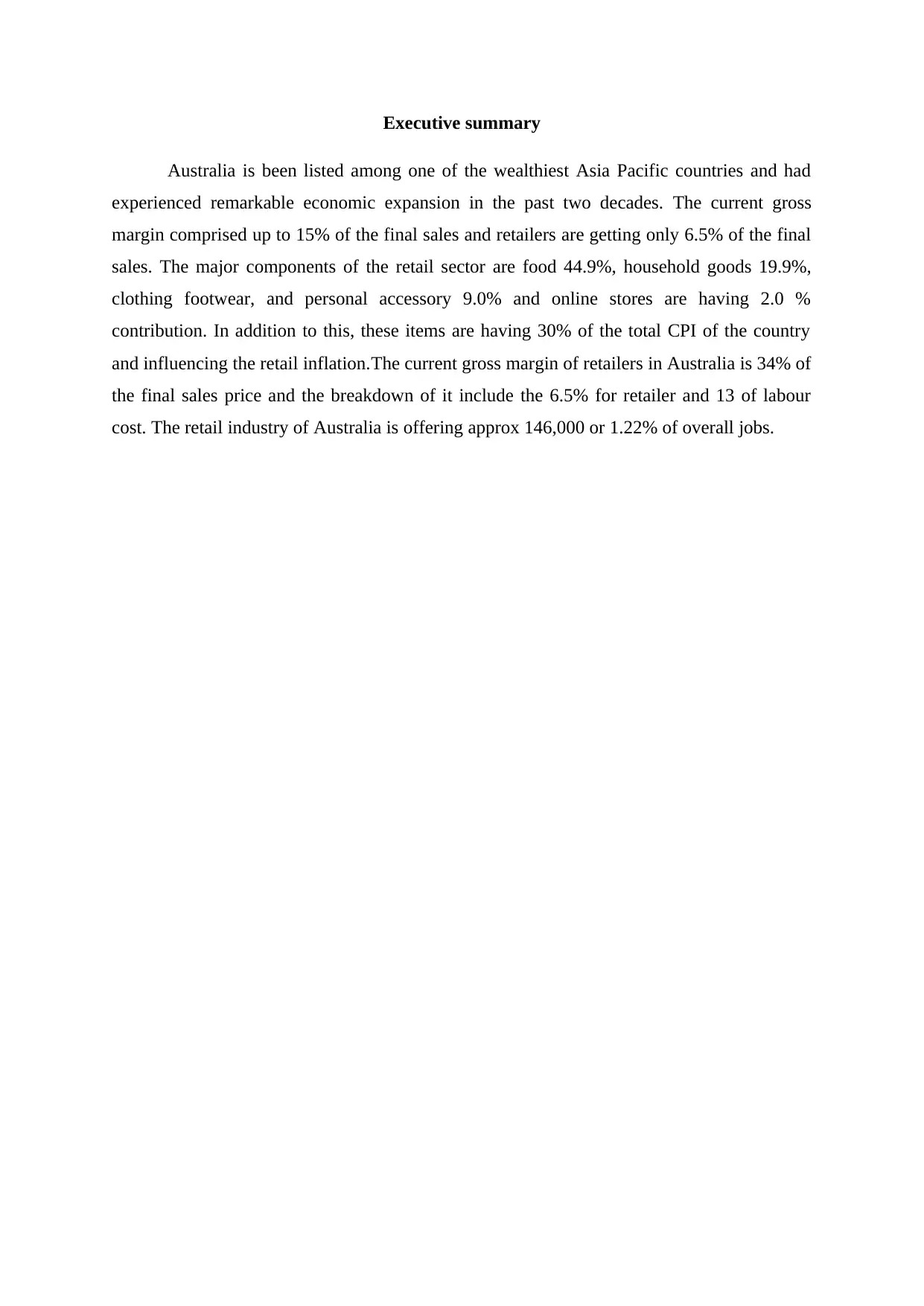
Executive summary
Australia is been listed among one of the wealthiest Asia Pacific countries and had
experienced remarkable economic expansion in the past two decades. The current gross
margin comprised up to 15% of the final sales and retailers are getting only 6.5% of the final
sales. The major components of the retail sector are food 44.9%, household goods 19.9%,
clothing footwear, and personal accessory 9.0% and online stores are having 2.0 %
contribution. In addition to this, these items are having 30% of the total CPI of the country
and influencing the retail inflation.The current gross margin of retailers in Australia is 34% of
the final sales price and the breakdown of it include the 6.5% for retailer and 13 of labour
cost. The retail industry of Australia is offering approx 146,000 or 1.22% of overall jobs.
Australia is been listed among one of the wealthiest Asia Pacific countries and had
experienced remarkable economic expansion in the past two decades. The current gross
margin comprised up to 15% of the final sales and retailers are getting only 6.5% of the final
sales. The major components of the retail sector are food 44.9%, household goods 19.9%,
clothing footwear, and personal accessory 9.0% and online stores are having 2.0 %
contribution. In addition to this, these items are having 30% of the total CPI of the country
and influencing the retail inflation.The current gross margin of retailers in Australia is 34% of
the final sales price and the breakdown of it include the 6.5% for retailer and 13 of labour
cost. The retail industry of Australia is offering approx 146,000 or 1.22% of overall jobs.
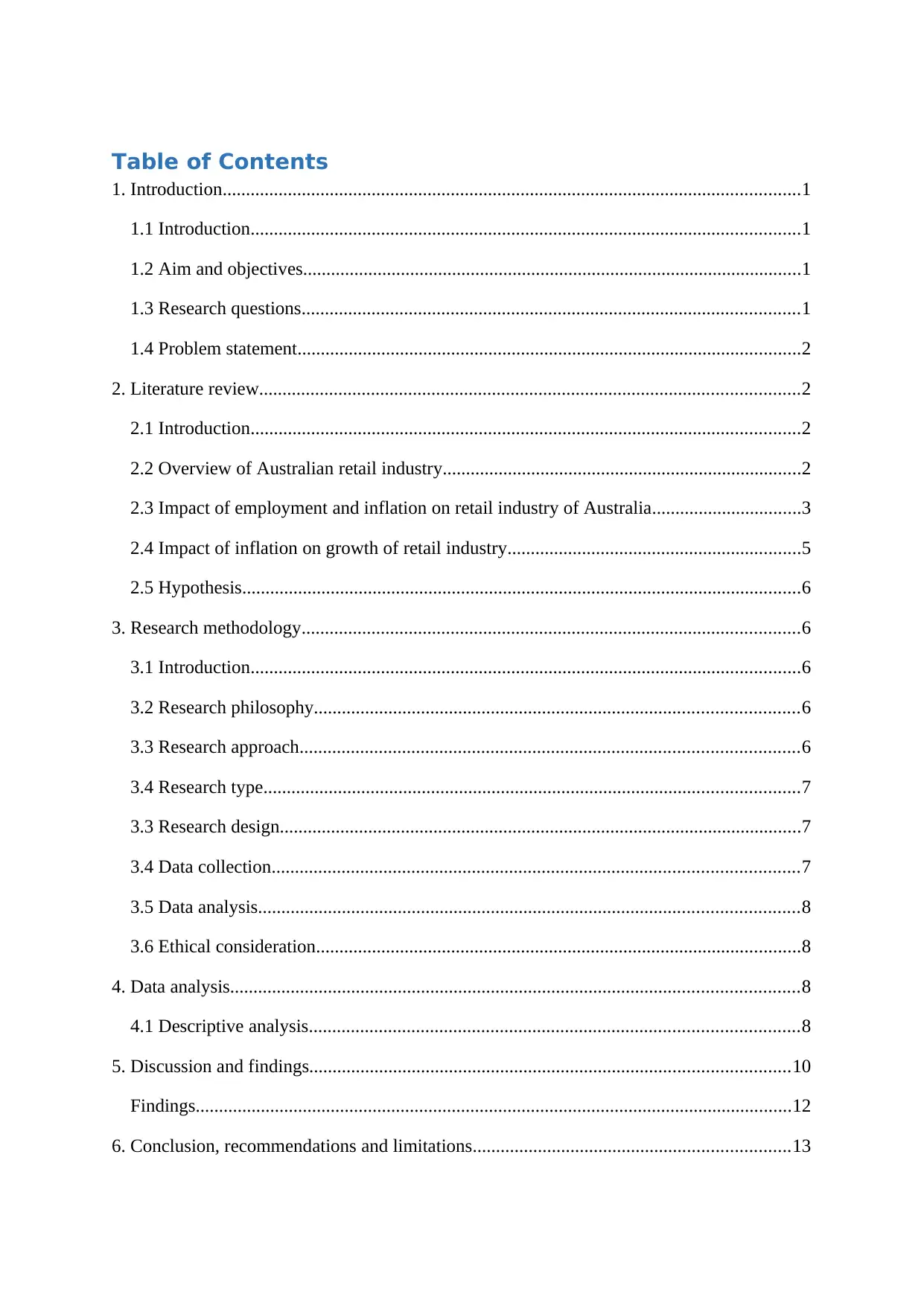
Table of Contents
1. Introduction............................................................................................................................1
1.1 Introduction......................................................................................................................1
1.2 Aim and objectives...........................................................................................................1
1.3 Research questions...........................................................................................................1
1.4 Problem statement............................................................................................................2
2. Literature review....................................................................................................................2
2.1 Introduction......................................................................................................................2
2.2 Overview of Australian retail industry.............................................................................2
2.3 Impact of employment and inflation on retail industry of Australia................................3
2.4 Impact of inflation on growth of retail industry...............................................................5
2.5 Hypothesis........................................................................................................................6
3. Research methodology...........................................................................................................6
3.1 Introduction......................................................................................................................6
3.2 Research philosophy........................................................................................................6
3.3 Research approach...........................................................................................................6
3.4 Research type...................................................................................................................7
3.3 Research design................................................................................................................7
3.4 Data collection.................................................................................................................7
3.5 Data analysis....................................................................................................................8
3.6 Ethical consideration........................................................................................................8
4. Data analysis..........................................................................................................................8
4.1 Descriptive analysis.........................................................................................................8
5. Discussion and findings.......................................................................................................10
Findings................................................................................................................................12
6. Conclusion, recommendations and limitations....................................................................13
1. Introduction............................................................................................................................1
1.1 Introduction......................................................................................................................1
1.2 Aim and objectives...........................................................................................................1
1.3 Research questions...........................................................................................................1
1.4 Problem statement............................................................................................................2
2. Literature review....................................................................................................................2
2.1 Introduction......................................................................................................................2
2.2 Overview of Australian retail industry.............................................................................2
2.3 Impact of employment and inflation on retail industry of Australia................................3
2.4 Impact of inflation on growth of retail industry...............................................................5
2.5 Hypothesis........................................................................................................................6
3. Research methodology...........................................................................................................6
3.1 Introduction......................................................................................................................6
3.2 Research philosophy........................................................................................................6
3.3 Research approach...........................................................................................................6
3.4 Research type...................................................................................................................7
3.3 Research design................................................................................................................7
3.4 Data collection.................................................................................................................7
3.5 Data analysis....................................................................................................................8
3.6 Ethical consideration........................................................................................................8
4. Data analysis..........................................................................................................................8
4.1 Descriptive analysis.........................................................................................................8
5. Discussion and findings.......................................................................................................10
Findings................................................................................................................................12
6. Conclusion, recommendations and limitations....................................................................13
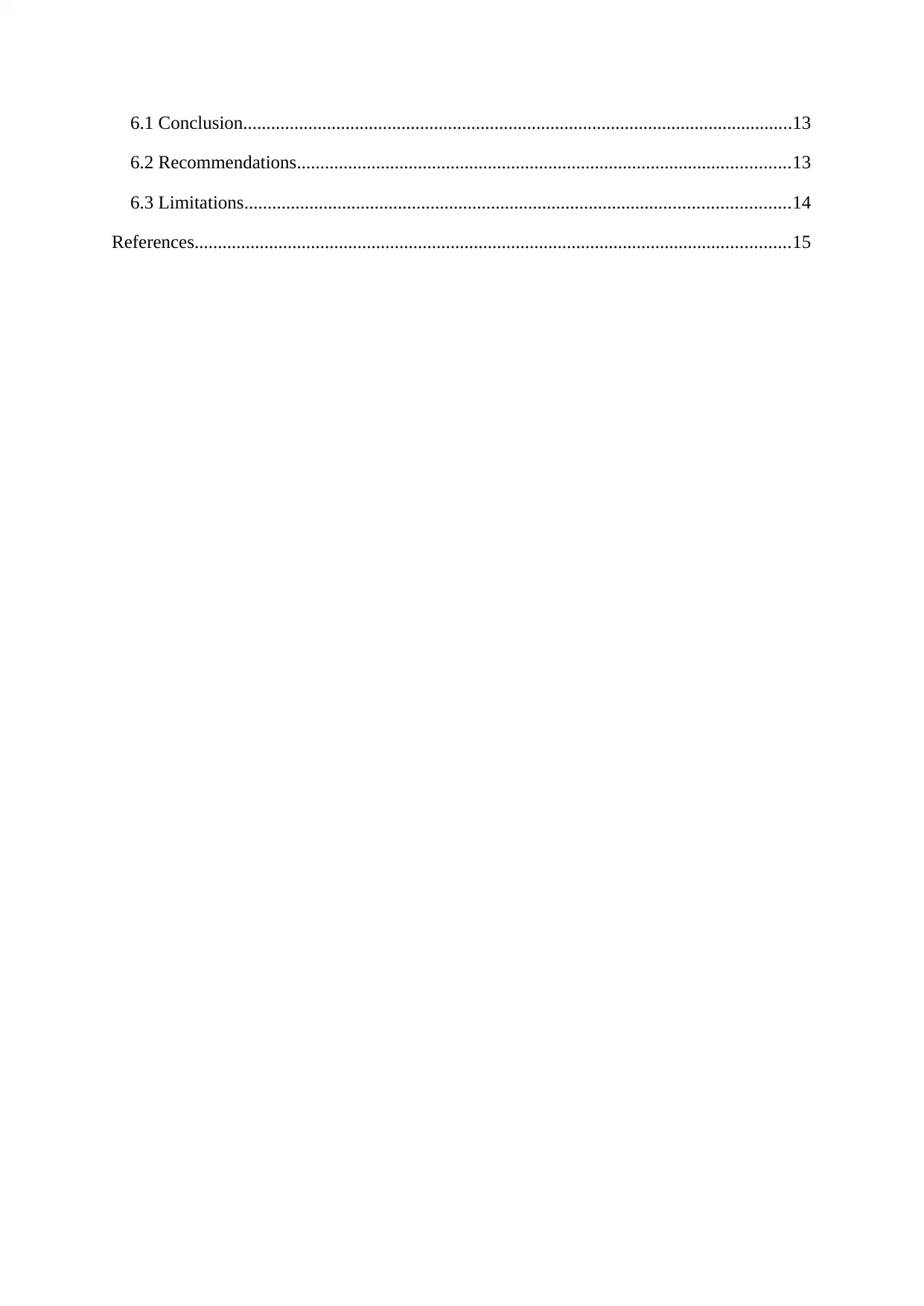
6.1 Conclusion......................................................................................................................13
6.2 Recommendations..........................................................................................................13
6.3 Limitations.....................................................................................................................14
References................................................................................................................................15
6.2 Recommendations..........................................................................................................13
6.3 Limitations.....................................................................................................................14
References................................................................................................................................15
Secure Best Marks with AI Grader
Need help grading? Try our AI Grader for instant feedback on your assignments.
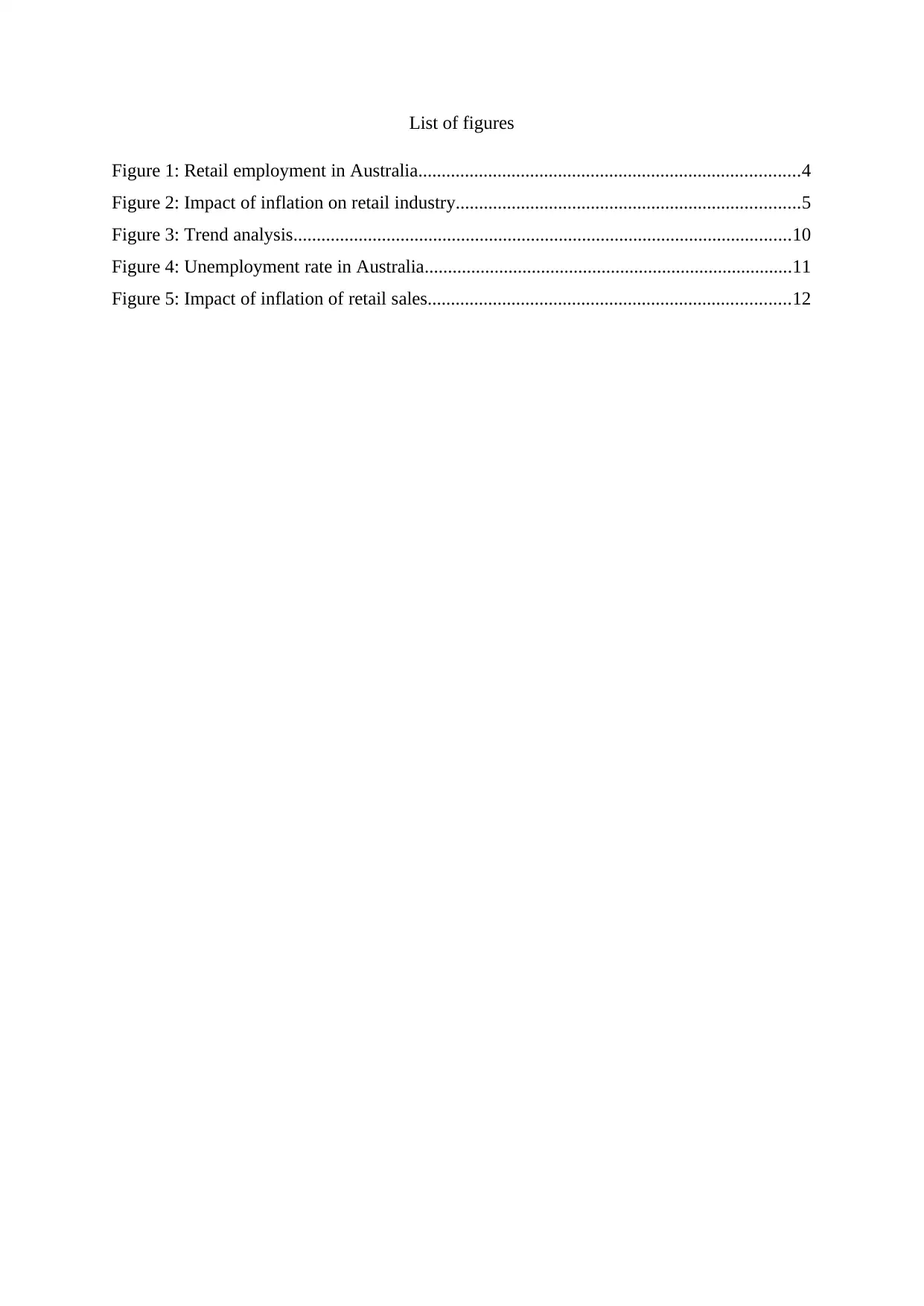
List of figures
Figure 1: Retail employment in Australia..................................................................................4
Figure 2: Impact of inflation on retail industry..........................................................................5
Figure 3: Trend analysis...........................................................................................................10
Figure 4: Unemployment rate in Australia...............................................................................11
Figure 5: Impact of inflation of retail sales..............................................................................12
Figure 1: Retail employment in Australia..................................................................................4
Figure 2: Impact of inflation on retail industry..........................................................................5
Figure 3: Trend analysis...........................................................................................................10
Figure 4: Unemployment rate in Australia...............................................................................11
Figure 5: Impact of inflation of retail sales..............................................................................12
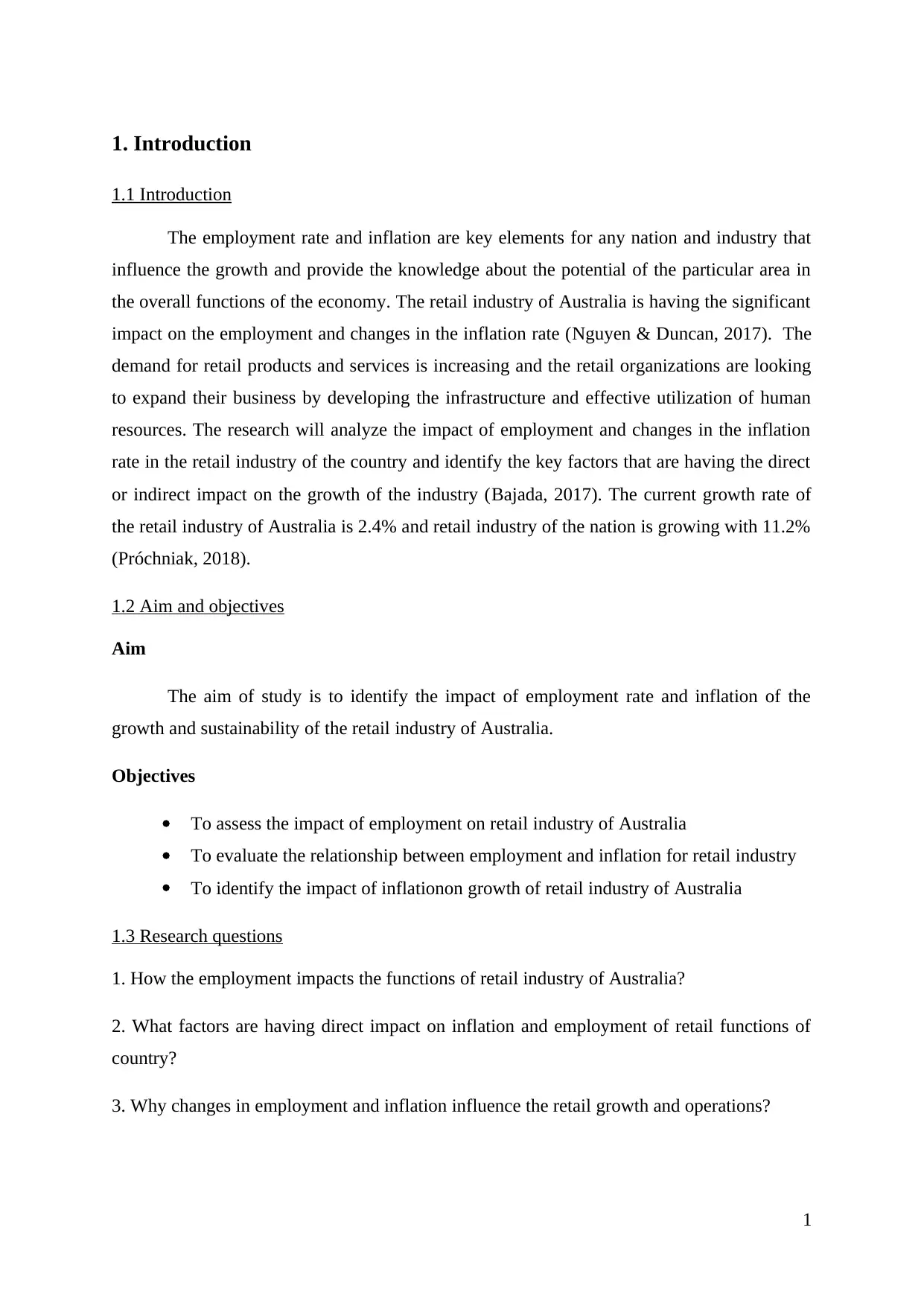
1. Introduction
1.1 Introduction
The employment rate and inflation are key elements for any nation and industry that
influence the growth and provide the knowledge about the potential of the particular area in
the overall functions of the economy. The retail industry of Australia is having the significant
impact on the employment and changes in the inflation rate (Nguyen & Duncan, 2017). The
demand for retail products and services is increasing and the retail organizations are looking
to expand their business by developing the infrastructure and effective utilization of human
resources. The research will analyze the impact of employment and changes in the inflation
rate in the retail industry of the country and identify the key factors that are having the direct
or indirect impact on the growth of the industry (Bajada, 2017). The current growth rate of
the retail industry of Australia is 2.4% and retail industry of the nation is growing with 11.2%
(Próchniak, 2018).
1.2 Aim and objectives
Aim
The aim of study is to identify the impact of employment rate and inflation of the
growth and sustainability of the retail industry of Australia.
Objectives
To assess the impact of employment on retail industry of Australia
To evaluate the relationship between employment and inflation for retail industry
To identify the impact of inflationon growth of retail industry of Australia
1.3 Research questions
1. How the employment impacts the functions of retail industry of Australia?
2. What factors are having direct impact on inflation and employment of retail functions of
country?
3. Why changes in employment and inflation influence the retail growth and operations?
1
1.1 Introduction
The employment rate and inflation are key elements for any nation and industry that
influence the growth and provide the knowledge about the potential of the particular area in
the overall functions of the economy. The retail industry of Australia is having the significant
impact on the employment and changes in the inflation rate (Nguyen & Duncan, 2017). The
demand for retail products and services is increasing and the retail organizations are looking
to expand their business by developing the infrastructure and effective utilization of human
resources. The research will analyze the impact of employment and changes in the inflation
rate in the retail industry of the country and identify the key factors that are having the direct
or indirect impact on the growth of the industry (Bajada, 2017). The current growth rate of
the retail industry of Australia is 2.4% and retail industry of the nation is growing with 11.2%
(Próchniak, 2018).
1.2 Aim and objectives
Aim
The aim of study is to identify the impact of employment rate and inflation of the
growth and sustainability of the retail industry of Australia.
Objectives
To assess the impact of employment on retail industry of Australia
To evaluate the relationship between employment and inflation for retail industry
To identify the impact of inflationon growth of retail industry of Australia
1.3 Research questions
1. How the employment impacts the functions of retail industry of Australia?
2. What factors are having direct impact on inflation and employment of retail functions of
country?
3. Why changes in employment and inflation influence the retail growth and operations?
1
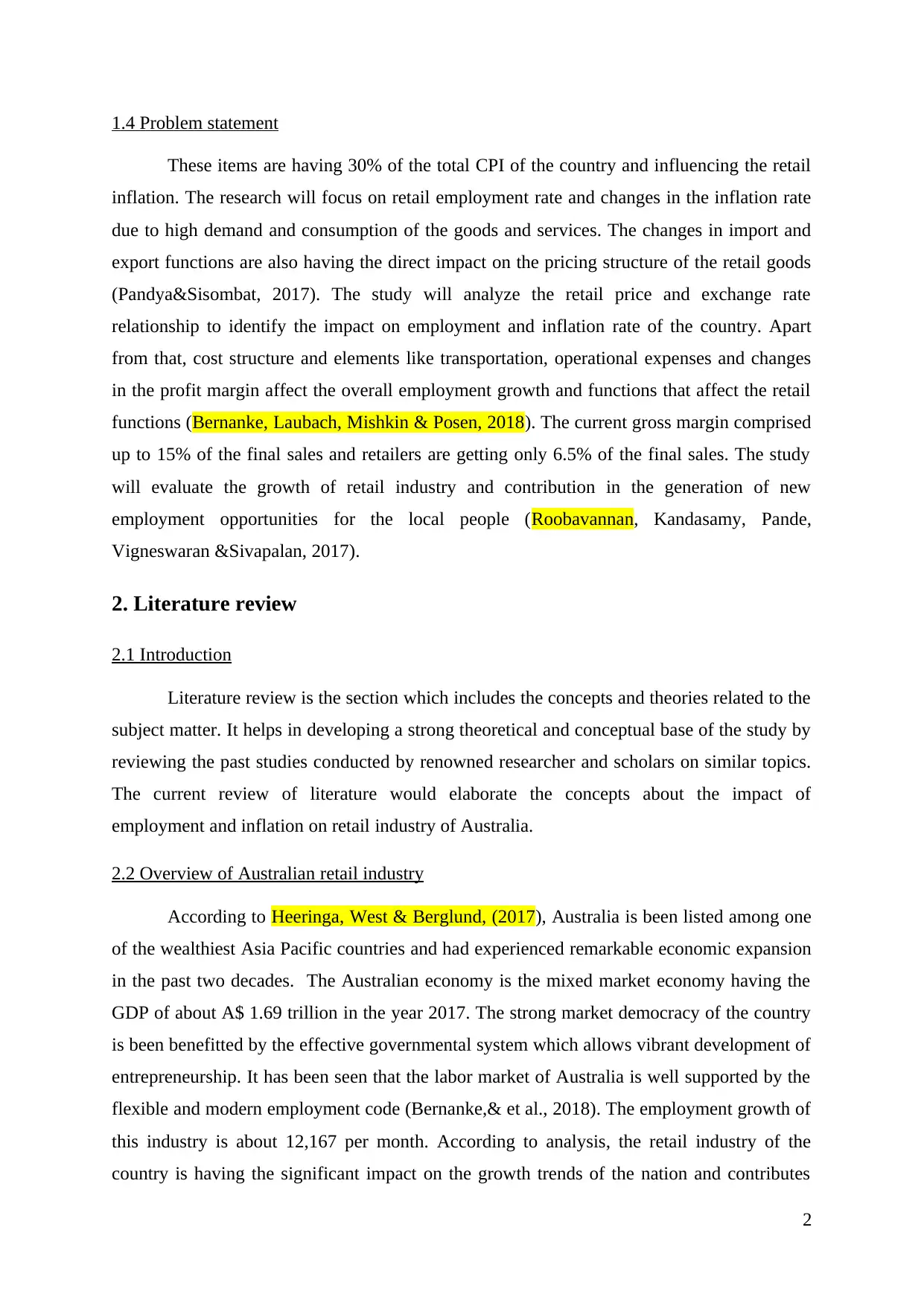
1.4 Problem statement
These items are having 30% of the total CPI of the country and influencing the retail
inflation. The research will focus on retail employment rate and changes in the inflation rate
due to high demand and consumption of the goods and services. The changes in import and
export functions are also having the direct impact on the pricing structure of the retail goods
(Pandya&Sisombat, 2017). The study will analyze the retail price and exchange rate
relationship to identify the impact on employment and inflation rate of the country. Apart
from that, cost structure and elements like transportation, operational expenses and changes
in the profit margin affect the overall employment growth and functions that affect the retail
functions (Bernanke, Laubach, Mishkin & Posen, 2018). The current gross margin comprised
up to 15% of the final sales and retailers are getting only 6.5% of the final sales. The study
will evaluate the growth of retail industry and contribution in the generation of new
employment opportunities for the local people (Roobavannan, Kandasamy, Pande,
Vigneswaran &Sivapalan, 2017).
2. Literature review
2.1 Introduction
Literature review is the section which includes the concepts and theories related to the
subject matter. It helps in developing a strong theoretical and conceptual base of the study by
reviewing the past studies conducted by renowned researcher and scholars on similar topics.
The current review of literature would elaborate the concepts about the impact of
employment and inflation on retail industry of Australia.
2.2 Overview of Australian retail industry
According to Heeringa, West & Berglund, (2017), Australia is been listed among one
of the wealthiest Asia Pacific countries and had experienced remarkable economic expansion
in the past two decades. The Australian economy is the mixed market economy having the
GDP of about A$ 1.69 trillion in the year 2017. The strong market democracy of the country
is been benefitted by the effective governmental system which allows vibrant development of
entrepreneurship. It has been seen that the labor market of Australia is well supported by the
flexible and modern employment code (Bernanke,& et al., 2018). The employment growth of
this industry is about 12,167 per month. According to analysis, the retail industry of the
country is having the significant impact on the growth trends of the nation and contributes
2
These items are having 30% of the total CPI of the country and influencing the retail
inflation. The research will focus on retail employment rate and changes in the inflation rate
due to high demand and consumption of the goods and services. The changes in import and
export functions are also having the direct impact on the pricing structure of the retail goods
(Pandya&Sisombat, 2017). The study will analyze the retail price and exchange rate
relationship to identify the impact on employment and inflation rate of the country. Apart
from that, cost structure and elements like transportation, operational expenses and changes
in the profit margin affect the overall employment growth and functions that affect the retail
functions (Bernanke, Laubach, Mishkin & Posen, 2018). The current gross margin comprised
up to 15% of the final sales and retailers are getting only 6.5% of the final sales. The study
will evaluate the growth of retail industry and contribution in the generation of new
employment opportunities for the local people (Roobavannan, Kandasamy, Pande,
Vigneswaran &Sivapalan, 2017).
2. Literature review
2.1 Introduction
Literature review is the section which includes the concepts and theories related to the
subject matter. It helps in developing a strong theoretical and conceptual base of the study by
reviewing the past studies conducted by renowned researcher and scholars on similar topics.
The current review of literature would elaborate the concepts about the impact of
employment and inflation on retail industry of Australia.
2.2 Overview of Australian retail industry
According to Heeringa, West & Berglund, (2017), Australia is been listed among one
of the wealthiest Asia Pacific countries and had experienced remarkable economic expansion
in the past two decades. The Australian economy is the mixed market economy having the
GDP of about A$ 1.69 trillion in the year 2017. The strong market democracy of the country
is been benefitted by the effective governmental system which allows vibrant development of
entrepreneurship. It has been seen that the labor market of Australia is well supported by the
flexible and modern employment code (Bernanke,& et al., 2018). The employment growth of
this industry is about 12,167 per month. According to analysis, the retail industry of the
country is having the significant impact on the growth trends of the nation and contributes
2
Paraphrase This Document
Need a fresh take? Get an instant paraphrase of this document with our AI Paraphraser
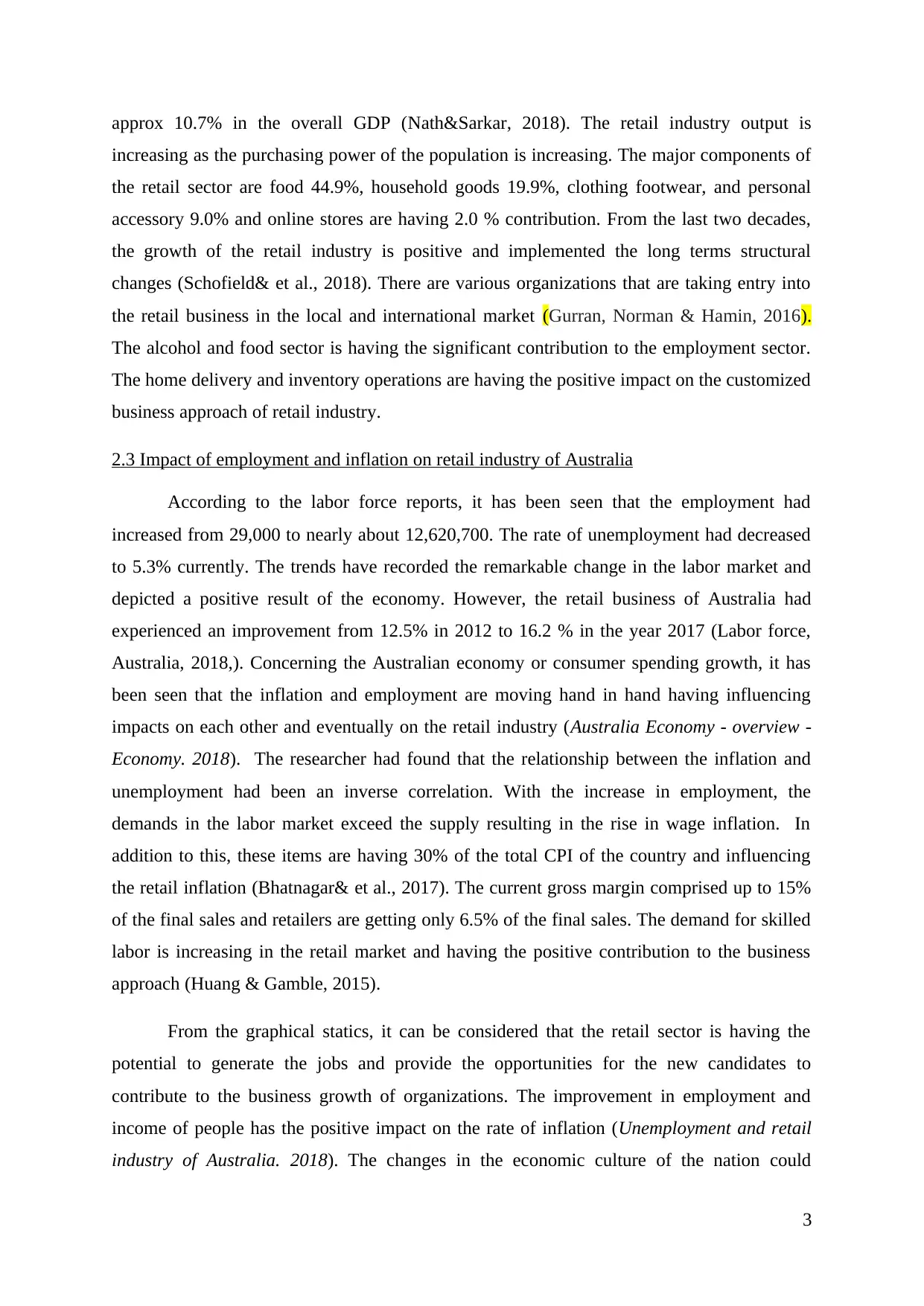
approx 10.7% in the overall GDP (Nath&Sarkar, 2018). The retail industry output is
increasing as the purchasing power of the population is increasing. The major components of
the retail sector are food 44.9%, household goods 19.9%, clothing footwear, and personal
accessory 9.0% and online stores are having 2.0 % contribution. From the last two decades,
the growth of the retail industry is positive and implemented the long terms structural
changes (Schofield& et al., 2018). There are various organizations that are taking entry into
the retail business in the local and international market (Gurran, Norman & Hamin, 2016).
The alcohol and food sector is having the significant contribution to the employment sector.
The home delivery and inventory operations are having the positive impact on the customized
business approach of retail industry.
2.3 Impact of employment and inflation on retail industry of Australia
According to the labor force reports, it has been seen that the employment had
increased from 29,000 to nearly about 12,620,700. The rate of unemployment had decreased
to 5.3% currently. The trends have recorded the remarkable change in the labor market and
depicted a positive result of the economy. However, the retail business of Australia had
experienced an improvement from 12.5% in 2012 to 16.2 % in the year 2017 (Labor force,
Australia, 2018,). Concerning the Australian economy or consumer spending growth, it has
been seen that the inflation and employment are moving hand in hand having influencing
impacts on each other and eventually on the retail industry (Australia Economy - overview -
Economy. 2018). The researcher had found that the relationship between the inflation and
unemployment had been an inverse correlation. With the increase in employment, the
demands in the labor market exceed the supply resulting in the rise in wage inflation. In
addition to this, these items are having 30% of the total CPI of the country and influencing
the retail inflation (Bhatnagar& et al., 2017). The current gross margin comprised up to 15%
of the final sales and retailers are getting only 6.5% of the final sales. The demand for skilled
labor is increasing in the retail market and having the positive contribution to the business
approach (Huang & Gamble, 2015).
From the graphical statics, it can be considered that the retail sector is having the
potential to generate the jobs and provide the opportunities for the new candidates to
contribute to the business growth of organizations. The improvement in employment and
income of people has the positive impact on the rate of inflation (Unemployment and retail
industry of Australia. 2018). The changes in the economic culture of the nation could
3
increasing as the purchasing power of the population is increasing. The major components of
the retail sector are food 44.9%, household goods 19.9%, clothing footwear, and personal
accessory 9.0% and online stores are having 2.0 % contribution. From the last two decades,
the growth of the retail industry is positive and implemented the long terms structural
changes (Schofield& et al., 2018). There are various organizations that are taking entry into
the retail business in the local and international market (Gurran, Norman & Hamin, 2016).
The alcohol and food sector is having the significant contribution to the employment sector.
The home delivery and inventory operations are having the positive impact on the customized
business approach of retail industry.
2.3 Impact of employment and inflation on retail industry of Australia
According to the labor force reports, it has been seen that the employment had
increased from 29,000 to nearly about 12,620,700. The rate of unemployment had decreased
to 5.3% currently. The trends have recorded the remarkable change in the labor market and
depicted a positive result of the economy. However, the retail business of Australia had
experienced an improvement from 12.5% in 2012 to 16.2 % in the year 2017 (Labor force,
Australia, 2018,). Concerning the Australian economy or consumer spending growth, it has
been seen that the inflation and employment are moving hand in hand having influencing
impacts on each other and eventually on the retail industry (Australia Economy - overview -
Economy. 2018). The researcher had found that the relationship between the inflation and
unemployment had been an inverse correlation. With the increase in employment, the
demands in the labor market exceed the supply resulting in the rise in wage inflation. In
addition to this, these items are having 30% of the total CPI of the country and influencing
the retail inflation (Bhatnagar& et al., 2017). The current gross margin comprised up to 15%
of the final sales and retailers are getting only 6.5% of the final sales. The demand for skilled
labor is increasing in the retail market and having the positive contribution to the business
approach (Huang & Gamble, 2015).
From the graphical statics, it can be considered that the retail sector is having the
potential to generate the jobs and provide the opportunities for the new candidates to
contribute to the business growth of organizations. The improvement in employment and
income of people has the positive impact on the rate of inflation (Unemployment and retail
industry of Australia. 2018). The changes in the economic culture of the nation could
3
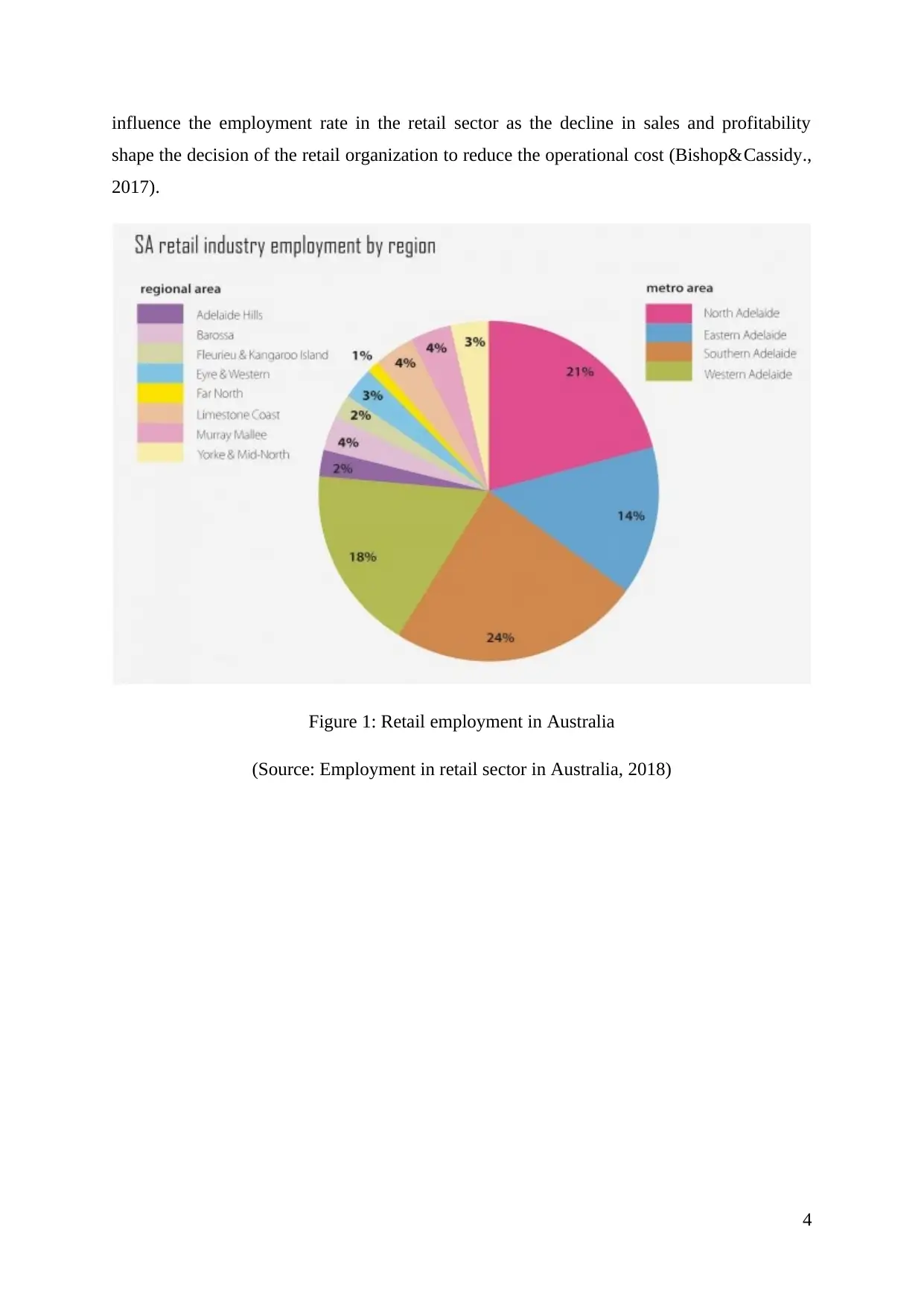
influence the employment rate in the retail sector as the decline in sales and profitability
shape the decision of the retail organization to reduce the operational cost (Bishop&Cassidy.,
2017).
Figure 1: Retail employment in Australia
(Source: Employment in retail sector in Australia, 2018)
4
shape the decision of the retail organization to reduce the operational cost (Bishop&Cassidy.,
2017).
Figure 1: Retail employment in Australia
(Source: Employment in retail sector in Australia, 2018)
4
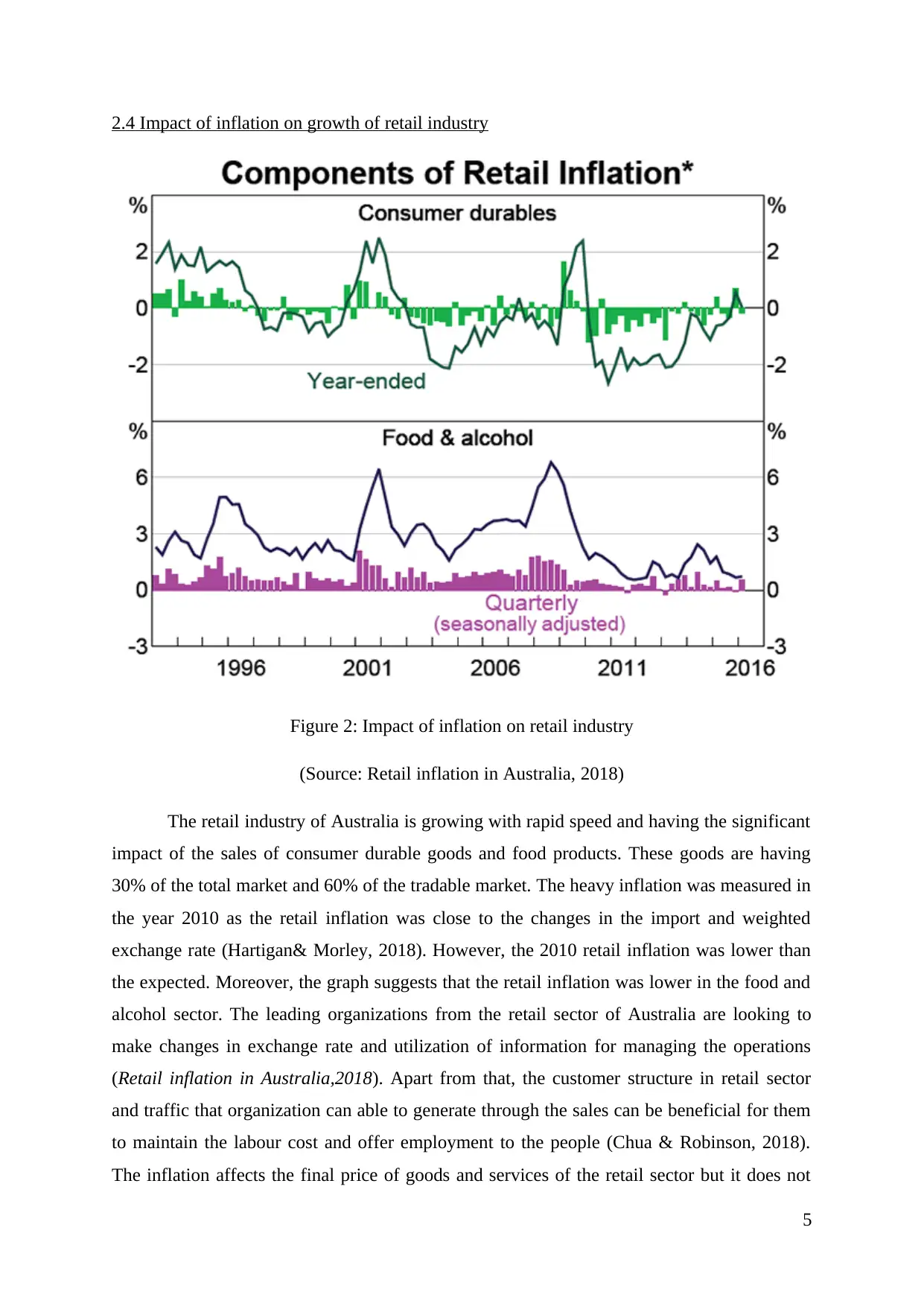
2.4 Impact of inflation on growth of retail industry
Figure 2: Impact of inflation on retail industry
(Source: Retail inflation in Australia, 2018)
The retail industry of Australia is growing with rapid speed and having the significant
impact of the sales of consumer durable goods and food products. These goods are having
30% of the total market and 60% of the tradable market. The heavy inflation was measured in
the year 2010 as the retail inflation was close to the changes in the import and weighted
exchange rate (Hartigan& Morley, 2018). However, the 2010 retail inflation was lower than
the expected. Moreover, the graph suggests that the retail inflation was lower in the food and
alcohol sector. The leading organizations from the retail sector of Australia are looking to
make changes in exchange rate and utilization of information for managing the operations
(Retail inflation in Australia,2018). Apart from that, the customer structure in retail sector
and traffic that organization can able to generate through the sales can be beneficial for them
to maintain the labour cost and offer employment to the people (Chua & Robinson, 2018).
The inflation affects the final price of goods and services of the retail sector but it does not
5
Figure 2: Impact of inflation on retail industry
(Source: Retail inflation in Australia, 2018)
The retail industry of Australia is growing with rapid speed and having the significant
impact of the sales of consumer durable goods and food products. These goods are having
30% of the total market and 60% of the tradable market. The heavy inflation was measured in
the year 2010 as the retail inflation was close to the changes in the import and weighted
exchange rate (Hartigan& Morley, 2018). However, the 2010 retail inflation was lower than
the expected. Moreover, the graph suggests that the retail inflation was lower in the food and
alcohol sector. The leading organizations from the retail sector of Australia are looking to
make changes in exchange rate and utilization of information for managing the operations
(Retail inflation in Australia,2018). Apart from that, the customer structure in retail sector
and traffic that organization can able to generate through the sales can be beneficial for them
to maintain the labour cost and offer employment to the people (Chua & Robinson, 2018).
The inflation affects the final price of goods and services of the retail sector but it does not
5
Secure Best Marks with AI Grader
Need help grading? Try our AI Grader for instant feedback on your assignments.
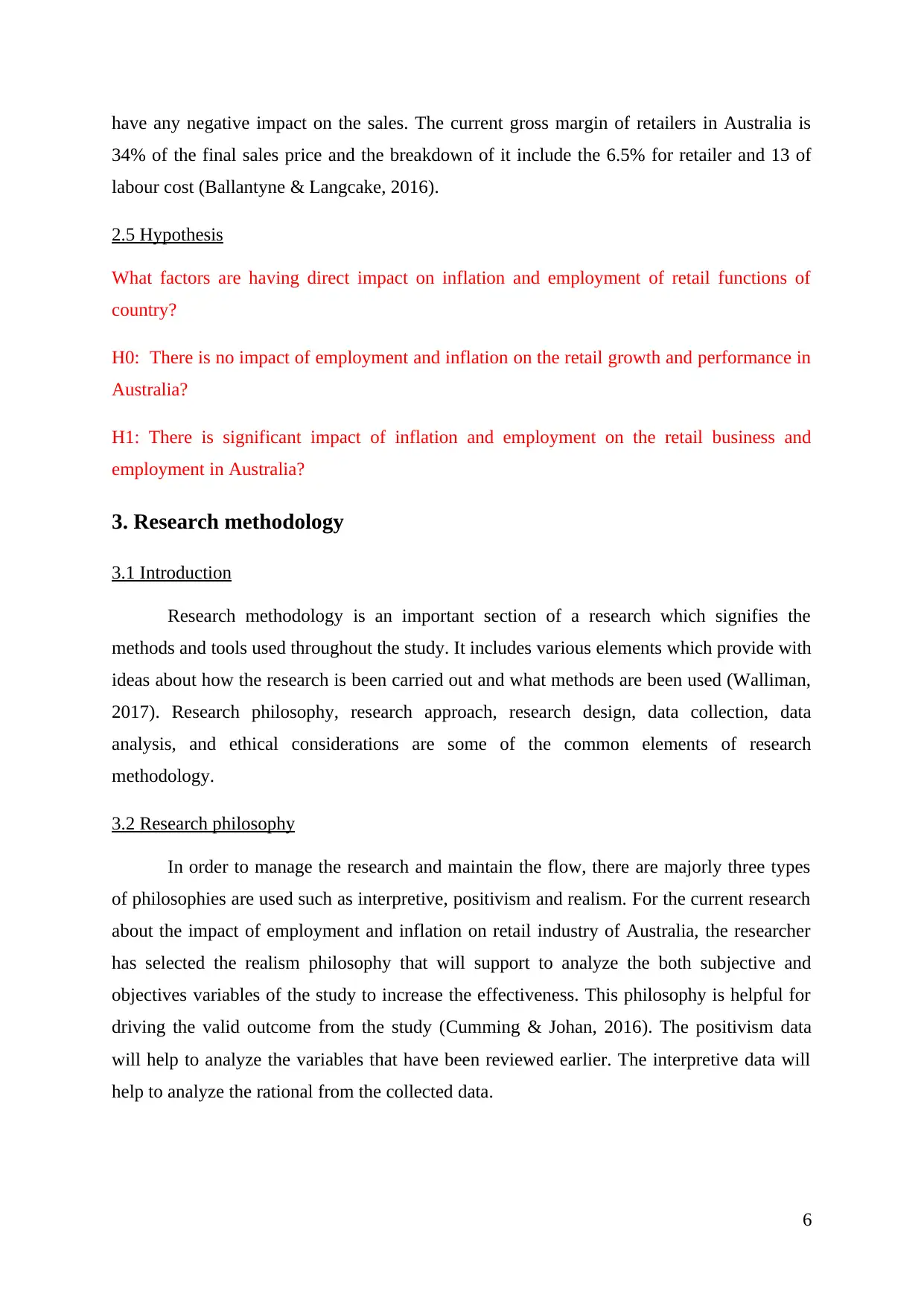
have any negative impact on the sales. The current gross margin of retailers in Australia is
34% of the final sales price and the breakdown of it include the 6.5% for retailer and 13 of
labour cost (Ballantyne & Langcake, 2016).
2.5 Hypothesis
What factors are having direct impact on inflation and employment of retail functions of
country?
H0: There is no impact of employment and inflation on the retail growth and performance in
Australia?
H1: There is significant impact of inflation and employment on the retail business and
employment in Australia?
3. Research methodology
3.1 Introduction
Research methodology is an important section of a research which signifies the
methods and tools used throughout the study. It includes various elements which provide with
ideas about how the research is been carried out and what methods are been used (Walliman,
2017). Research philosophy, research approach, research design, data collection, data
analysis, and ethical considerations are some of the common elements of research
methodology.
3.2 Research philosophy
In order to manage the research and maintain the flow, there are majorly three types
of philosophies are used such as interpretive, positivism and realism. For the current research
about the impact of employment and inflation on retail industry of Australia, the researcher
has selected the realism philosophy that will support to analyze the both subjective and
objectives variables of the study to increase the effectiveness. This philosophy is helpful for
driving the valid outcome from the study (Cumming & Johan, 2016). The positivism data
will help to analyze the variables that have been reviewed earlier. The interpretive data will
help to analyze the rational from the collected data.
6
34% of the final sales price and the breakdown of it include the 6.5% for retailer and 13 of
labour cost (Ballantyne & Langcake, 2016).
2.5 Hypothesis
What factors are having direct impact on inflation and employment of retail functions of
country?
H0: There is no impact of employment and inflation on the retail growth and performance in
Australia?
H1: There is significant impact of inflation and employment on the retail business and
employment in Australia?
3. Research methodology
3.1 Introduction
Research methodology is an important section of a research which signifies the
methods and tools used throughout the study. It includes various elements which provide with
ideas about how the research is been carried out and what methods are been used (Walliman,
2017). Research philosophy, research approach, research design, data collection, data
analysis, and ethical considerations are some of the common elements of research
methodology.
3.2 Research philosophy
In order to manage the research and maintain the flow, there are majorly three types
of philosophies are used such as interpretive, positivism and realism. For the current research
about the impact of employment and inflation on retail industry of Australia, the researcher
has selected the realism philosophy that will support to analyze the both subjective and
objectives variables of the study to increase the effectiveness. This philosophy is helpful for
driving the valid outcome from the study (Cumming & Johan, 2016). The positivism data
will help to analyze the variables that have been reviewed earlier. The interpretive data will
help to analyze the rational from the collected data.
6
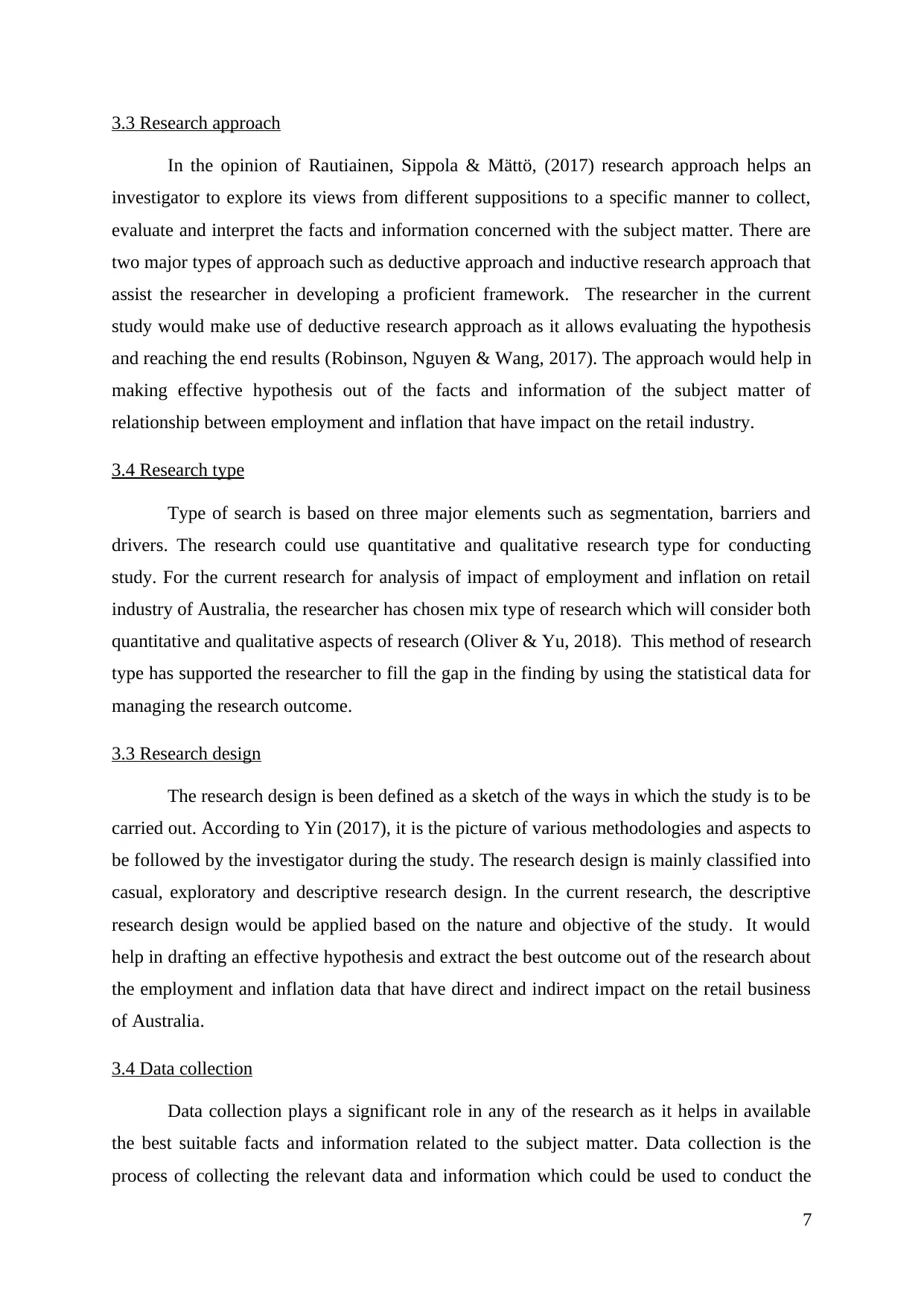
3.3 Research approach
In the opinion of Rautiainen, Sippola & Mättö, (2017) research approach helps an
investigator to explore its views from different suppositions to a specific manner to collect,
evaluate and interpret the facts and information concerned with the subject matter. There are
two major types of approach such as deductive approach and inductive research approach that
assist the researcher in developing a proficient framework. The researcher in the current
study would make use of deductive research approach as it allows evaluating the hypothesis
and reaching the end results (Robinson, Nguyen & Wang, 2017). The approach would help in
making effective hypothesis out of the facts and information of the subject matter of
relationship between employment and inflation that have impact on the retail industry.
3.4 Research type
Type of search is based on three major elements such as segmentation, barriers and
drivers. The research could use quantitative and qualitative research type for conducting
study. For the current research for analysis of impact of employment and inflation on retail
industry of Australia, the researcher has chosen mix type of research which will consider both
quantitative and qualitative aspects of research (Oliver & Yu, 2018). This method of research
type has supported the researcher to fill the gap in the finding by using the statistical data for
managing the research outcome.
3.3 Research design
The research design is been defined as a sketch of the ways in which the study is to be
carried out. According to Yin (2017), it is the picture of various methodologies and aspects to
be followed by the investigator during the study. The research design is mainly classified into
casual, exploratory and descriptive research design. In the current research, the descriptive
research design would be applied based on the nature and objective of the study. It would
help in drafting an effective hypothesis and extract the best outcome out of the research about
the employment and inflation data that have direct and indirect impact on the retail business
of Australia.
3.4 Data collection
Data collection plays a significant role in any of the research as it helps in available
the best suitable facts and information related to the subject matter. Data collection is the
process of collecting the relevant data and information which could be used to conduct the
7
In the opinion of Rautiainen, Sippola & Mättö, (2017) research approach helps an
investigator to explore its views from different suppositions to a specific manner to collect,
evaluate and interpret the facts and information concerned with the subject matter. There are
two major types of approach such as deductive approach and inductive research approach that
assist the researcher in developing a proficient framework. The researcher in the current
study would make use of deductive research approach as it allows evaluating the hypothesis
and reaching the end results (Robinson, Nguyen & Wang, 2017). The approach would help in
making effective hypothesis out of the facts and information of the subject matter of
relationship between employment and inflation that have impact on the retail industry.
3.4 Research type
Type of search is based on three major elements such as segmentation, barriers and
drivers. The research could use quantitative and qualitative research type for conducting
study. For the current research for analysis of impact of employment and inflation on retail
industry of Australia, the researcher has chosen mix type of research which will consider both
quantitative and qualitative aspects of research (Oliver & Yu, 2018). This method of research
type has supported the researcher to fill the gap in the finding by using the statistical data for
managing the research outcome.
3.3 Research design
The research design is been defined as a sketch of the ways in which the study is to be
carried out. According to Yin (2017), it is the picture of various methodologies and aspects to
be followed by the investigator during the study. The research design is mainly classified into
casual, exploratory and descriptive research design. In the current research, the descriptive
research design would be applied based on the nature and objective of the study. It would
help in drafting an effective hypothesis and extract the best outcome out of the research about
the employment and inflation data that have direct and indirect impact on the retail business
of Australia.
3.4 Data collection
Data collection plays a significant role in any of the research as it helps in available
the best suitable facts and information related to the subject matter. Data collection is the
process of collecting the relevant data and information which could be used to conduct the
7
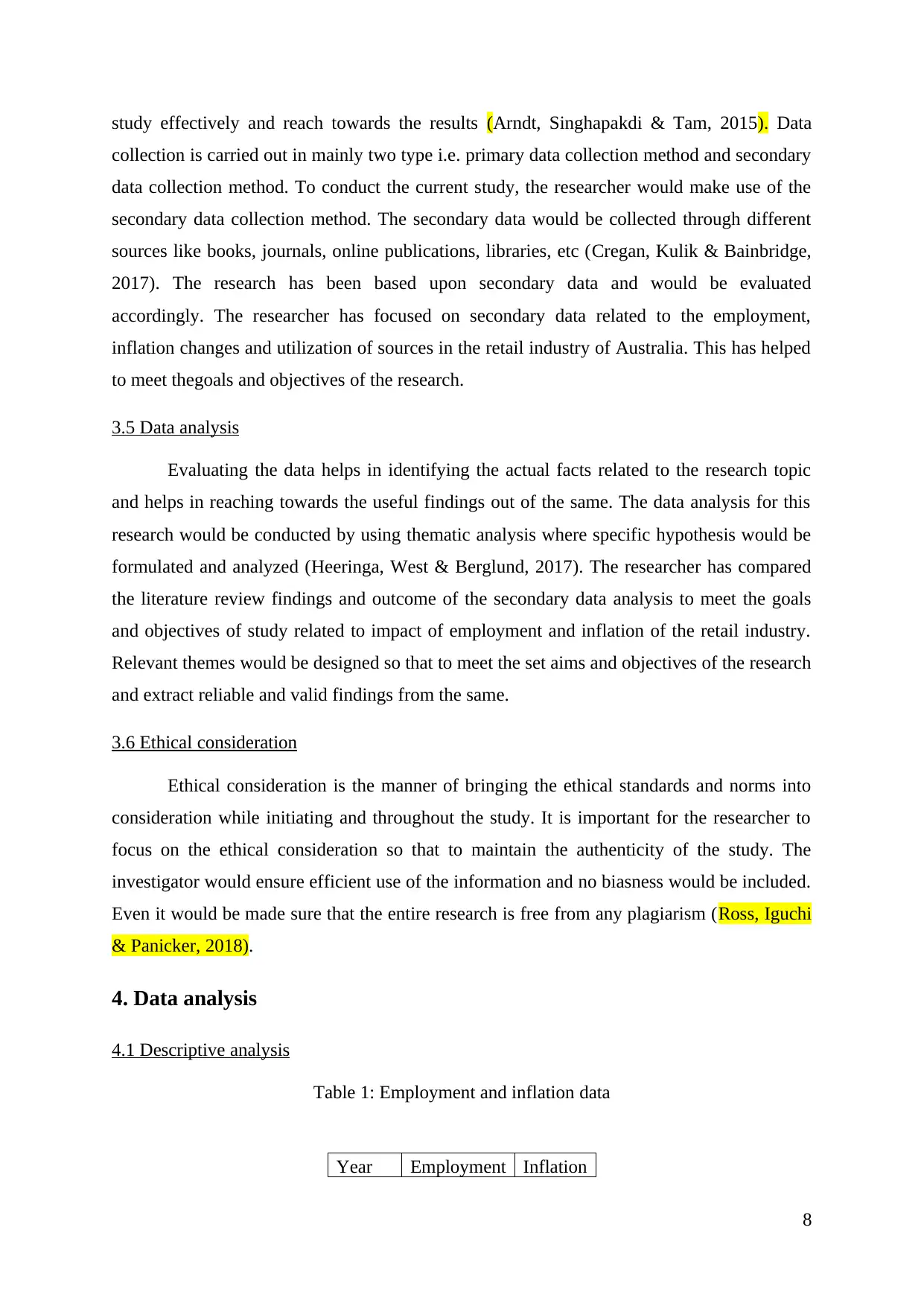
study effectively and reach towards the results (Arndt, Singhapakdi & Tam, 2015). Data
collection is carried out in mainly two type i.e. primary data collection method and secondary
data collection method. To conduct the current study, the researcher would make use of the
secondary data collection method. The secondary data would be collected through different
sources like books, journals, online publications, libraries, etc (Cregan, Kulik & Bainbridge,
2017). The research has been based upon secondary data and would be evaluated
accordingly. The researcher has focused on secondary data related to the employment,
inflation changes and utilization of sources in the retail industry of Australia. This has helped
to meet thegoals and objectives of the research.
3.5 Data analysis
Evaluating the data helps in identifying the actual facts related to the research topic
and helps in reaching towards the useful findings out of the same. The data analysis for this
research would be conducted by using thematic analysis where specific hypothesis would be
formulated and analyzed (Heeringa, West & Berglund, 2017). The researcher has compared
the literature review findings and outcome of the secondary data analysis to meet the goals
and objectives of study related to impact of employment and inflation of the retail industry.
Relevant themes would be designed so that to meet the set aims and objectives of the research
and extract reliable and valid findings from the same.
3.6 Ethical consideration
Ethical consideration is the manner of bringing the ethical standards and norms into
consideration while initiating and throughout the study. It is important for the researcher to
focus on the ethical consideration so that to maintain the authenticity of the study. The
investigator would ensure efficient use of the information and no biasness would be included.
Even it would be made sure that the entire research is free from any plagiarism (Ross, Iguchi
& Panicker, 2018).
4. Data analysis
4.1 Descriptive analysis
Table 1: Employment and inflation data
Year Employment Inflation
8
collection is carried out in mainly two type i.e. primary data collection method and secondary
data collection method. To conduct the current study, the researcher would make use of the
secondary data collection method. The secondary data would be collected through different
sources like books, journals, online publications, libraries, etc (Cregan, Kulik & Bainbridge,
2017). The research has been based upon secondary data and would be evaluated
accordingly. The researcher has focused on secondary data related to the employment,
inflation changes and utilization of sources in the retail industry of Australia. This has helped
to meet thegoals and objectives of the research.
3.5 Data analysis
Evaluating the data helps in identifying the actual facts related to the research topic
and helps in reaching towards the useful findings out of the same. The data analysis for this
research would be conducted by using thematic analysis where specific hypothesis would be
formulated and analyzed (Heeringa, West & Berglund, 2017). The researcher has compared
the literature review findings and outcome of the secondary data analysis to meet the goals
and objectives of study related to impact of employment and inflation of the retail industry.
Relevant themes would be designed so that to meet the set aims and objectives of the research
and extract reliable and valid findings from the same.
3.6 Ethical consideration
Ethical consideration is the manner of bringing the ethical standards and norms into
consideration while initiating and throughout the study. It is important for the researcher to
focus on the ethical consideration so that to maintain the authenticity of the study. The
investigator would ensure efficient use of the information and no biasness would be included.
Even it would be made sure that the entire research is free from any plagiarism (Ross, Iguchi
& Panicker, 2018).
4. Data analysis
4.1 Descriptive analysis
Table 1: Employment and inflation data
Year Employment Inflation
8
Paraphrase This Document
Need a fresh take? Get an instant paraphrase of this document with our AI Paraphraser
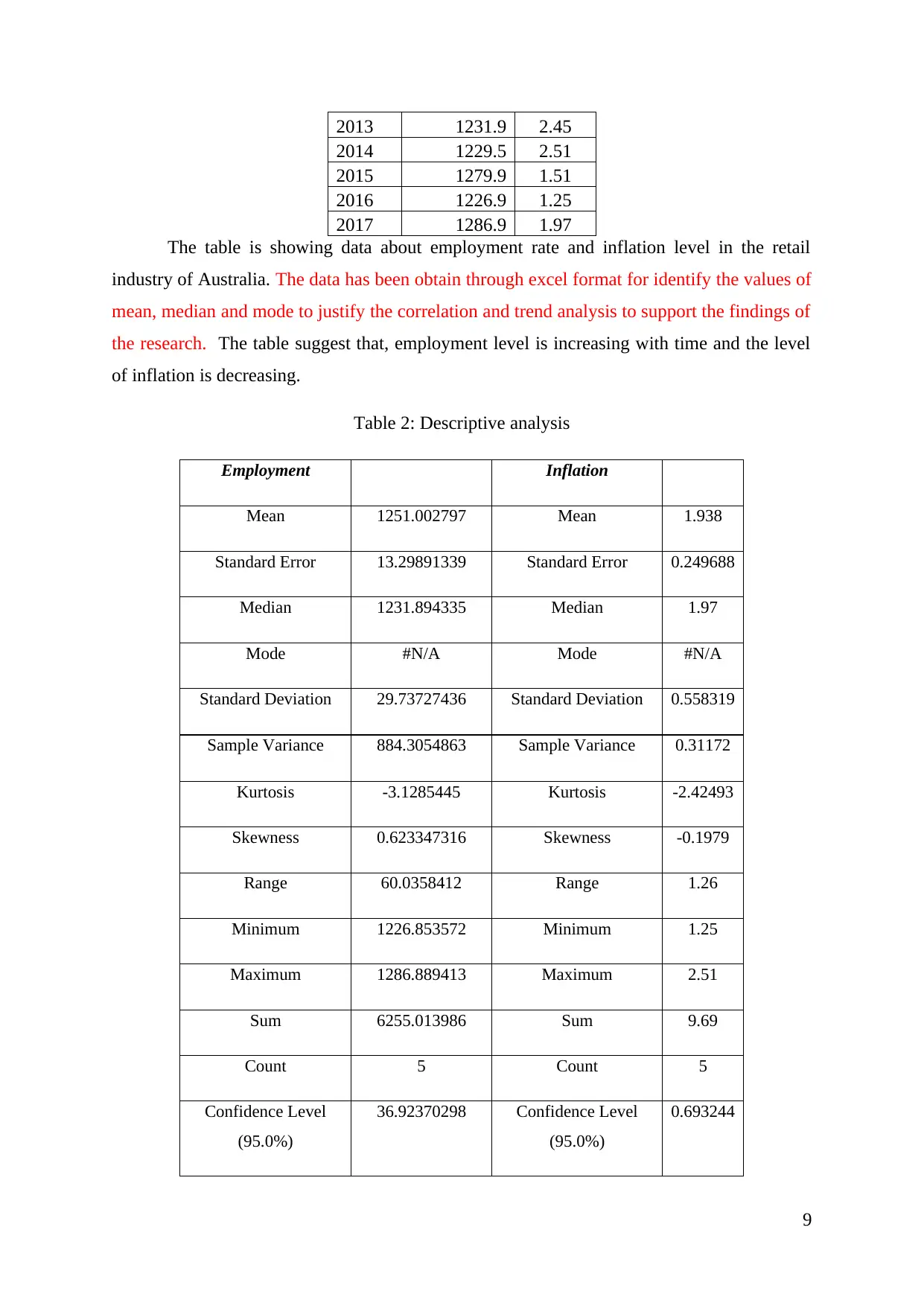
2013 1231.9 2.45
2014 1229.5 2.51
2015 1279.9 1.51
2016 1226.9 1.25
2017 1286.9 1.97
The table is showing data about employment rate and inflation level in the retail
industry of Australia. The data has been obtain through excel format for identify the values of
mean, median and mode to justify the correlation and trend analysis to support the findings of
the research. The table suggest that, employment level is increasing with time and the level
of inflation is decreasing.
Table 2: Descriptive analysis
Employment Inflation
Mean 1251.002797 Mean 1.938
Standard Error 13.29891339 Standard Error 0.249688
Median 1231.894335 Median 1.97
Mode #N/A Mode #N/A
Standard Deviation 29.73727436 Standard Deviation 0.558319
Sample Variance 884.3054863 Sample Variance 0.31172
Kurtosis -3.1285445 Kurtosis -2.42493
Skewness 0.623347316 Skewness -0.1979
Range 60.0358412 Range 1.26
Minimum 1226.853572 Minimum 1.25
Maximum 1286.889413 Maximum 2.51
Sum 6255.013986 Sum 9.69
Count 5 Count 5
Confidence Level
(95.0%)
36.92370298 Confidence Level
(95.0%)
0.693244
9
2014 1229.5 2.51
2015 1279.9 1.51
2016 1226.9 1.25
2017 1286.9 1.97
The table is showing data about employment rate and inflation level in the retail
industry of Australia. The data has been obtain through excel format for identify the values of
mean, median and mode to justify the correlation and trend analysis to support the findings of
the research. The table suggest that, employment level is increasing with time and the level
of inflation is decreasing.
Table 2: Descriptive analysis
Employment Inflation
Mean 1251.002797 Mean 1.938
Standard Error 13.29891339 Standard Error 0.249688
Median 1231.894335 Median 1.97
Mode #N/A Mode #N/A
Standard Deviation 29.73727436 Standard Deviation 0.558319
Sample Variance 884.3054863 Sample Variance 0.31172
Kurtosis -3.1285445 Kurtosis -2.42493
Skewness 0.623347316 Skewness -0.1979
Range 60.0358412 Range 1.26
Minimum 1226.853572 Minimum 1.25
Maximum 1286.889413 Maximum 2.51
Sum 6255.013986 Sum 9.69
Count 5 Count 5
Confidence Level
(95.0%)
36.92370298 Confidence Level
(95.0%)
0.693244
9
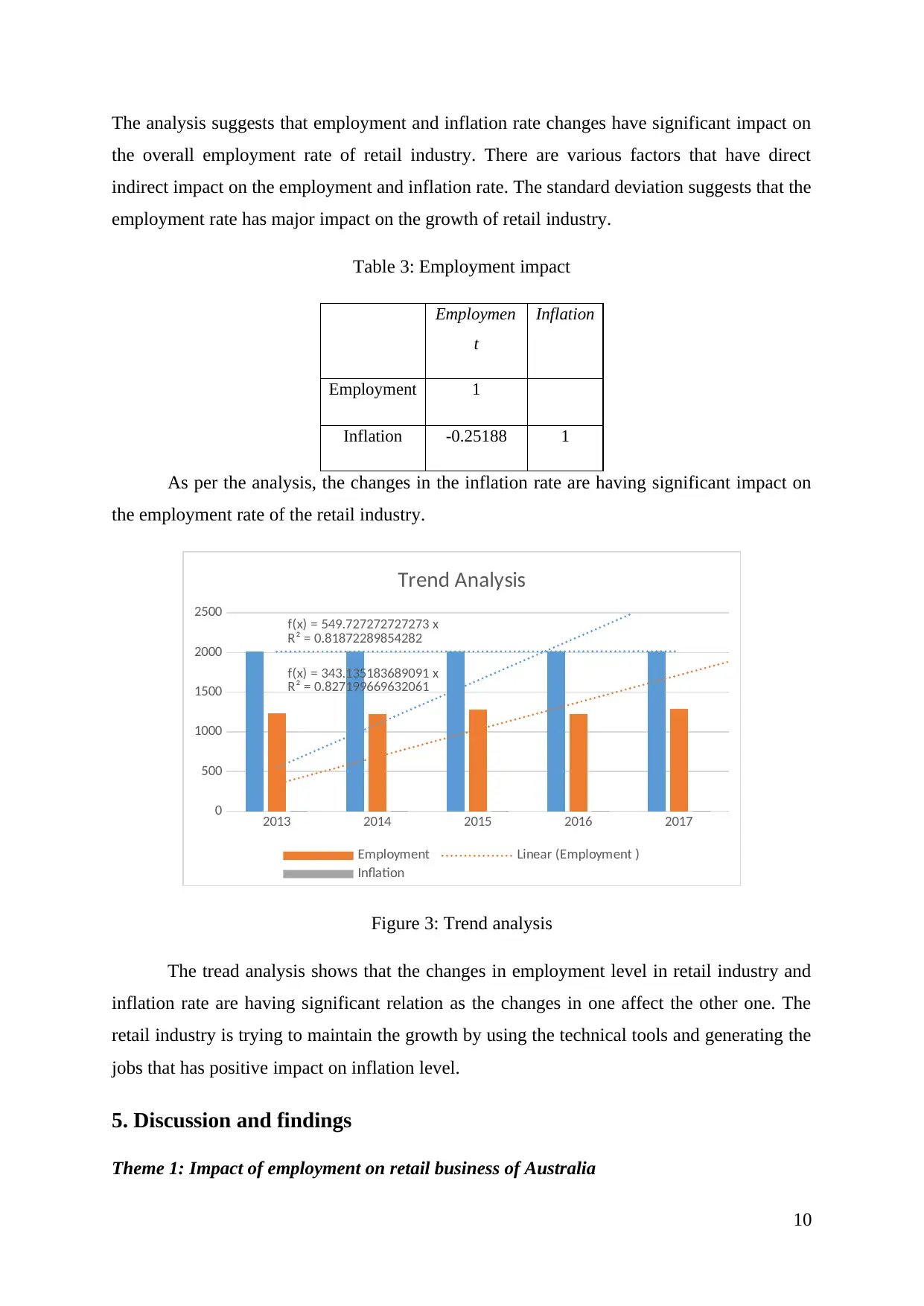
The analysis suggests that employment and inflation rate changes have significant impact on
the overall employment rate of retail industry. There are various factors that have direct
indirect impact on the employment and inflation rate. The standard deviation suggests that the
employment rate has major impact on the growth of retail industry.
Table 3: Employment impact
Employmen
t
Inflation
Employment 1
Inflation -0.25188 1
As per the analysis, the changes in the inflation rate are having significant impact on
the employment rate of the retail industry.
2013 2014 2015 2016 2017
0
500
1000
1500
2000
2500 f(x) = 549.727272727273 x
R² = 0.81872289854282
f(x) = 343.135183689091 x
R² = 0.827199669632061
Trend Analysis
Employment Linear (Employment )
Inflation
Figure 3: Trend analysis
The tread analysis shows that the changes in employment level in retail industry and
inflation rate are having significant relation as the changes in one affect the other one. The
retail industry is trying to maintain the growth by using the technical tools and generating the
jobs that has positive impact on inflation level.
5. Discussion and findings
Theme 1: Impact of employment on retail business of Australia
10
the overall employment rate of retail industry. There are various factors that have direct
indirect impact on the employment and inflation rate. The standard deviation suggests that the
employment rate has major impact on the growth of retail industry.
Table 3: Employment impact
Employmen
t
Inflation
Employment 1
Inflation -0.25188 1
As per the analysis, the changes in the inflation rate are having significant impact on
the employment rate of the retail industry.
2013 2014 2015 2016 2017
0
500
1000
1500
2000
2500 f(x) = 549.727272727273 x
R² = 0.81872289854282
f(x) = 343.135183689091 x
R² = 0.827199669632061
Trend Analysis
Employment Linear (Employment )
Inflation
Figure 3: Trend analysis
The tread analysis shows that the changes in employment level in retail industry and
inflation rate are having significant relation as the changes in one affect the other one. The
retail industry is trying to maintain the growth by using the technical tools and generating the
jobs that has positive impact on inflation level.
5. Discussion and findings
Theme 1: Impact of employment on retail business of Australia
10
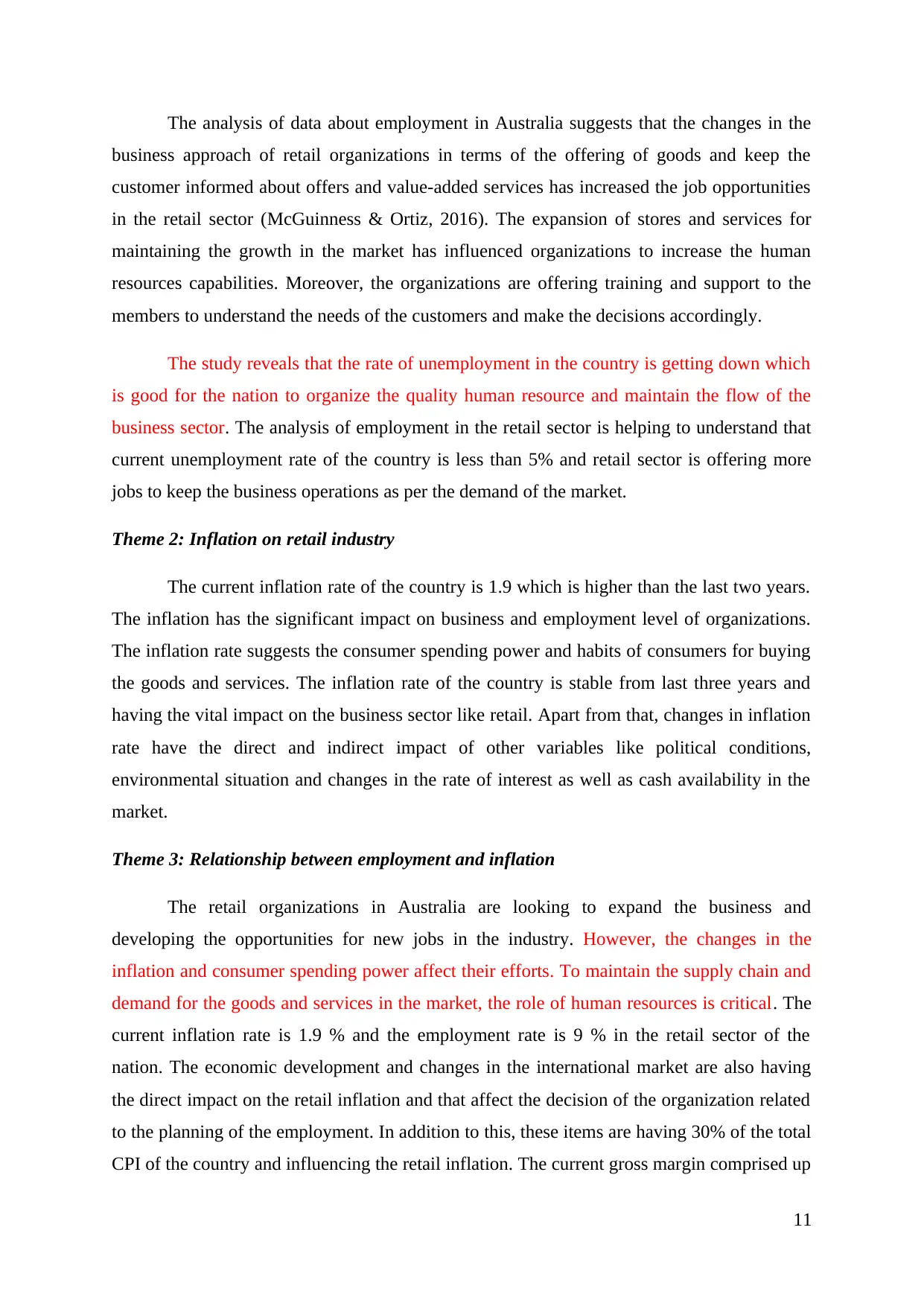
The analysis of data about employment in Australia suggests that the changes in the
business approach of retail organizations in terms of the offering of goods and keep the
customer informed about offers and value-added services has increased the job opportunities
in the retail sector (McGuinness & Ortiz, 2016). The expansion of stores and services for
maintaining the growth in the market has influenced organizations to increase the human
resources capabilities. Moreover, the organizations are offering training and support to the
members to understand the needs of the customers and make the decisions accordingly.
The study reveals that the rate of unemployment in the country is getting down which
is good for the nation to organize the quality human resource and maintain the flow of the
business sector. The analysis of employment in the retail sector is helping to understand that
current unemployment rate of the country is less than 5% and retail sector is offering more
jobs to keep the business operations as per the demand of the market.
Theme 2: Inflation on retail industry
The current inflation rate of the country is 1.9 which is higher than the last two years.
The inflation has the significant impact on business and employment level of organizations.
The inflation rate suggests the consumer spending power and habits of consumers for buying
the goods and services. The inflation rate of the country is stable from last three years and
having the vital impact on the business sector like retail. Apart from that, changes in inflation
rate have the direct and indirect impact of other variables like political conditions,
environmental situation and changes in the rate of interest as well as cash availability in the
market.
Theme 3: Relationship between employment and inflation
The retail organizations in Australia are looking to expand the business and
developing the opportunities for new jobs in the industry. However, the changes in the
inflation and consumer spending power affect their efforts. To maintain the supply chain and
demand for the goods and services in the market, the role of human resources is critical. The
current inflation rate is 1.9 % and the employment rate is 9 % in the retail sector of the
nation. The economic development and changes in the international market are also having
the direct impact on the retail inflation and that affect the decision of the organization related
to the planning of the employment. In addition to this, these items are having 30% of the total
CPI of the country and influencing the retail inflation. The current gross margin comprised up
11
business approach of retail organizations in terms of the offering of goods and keep the
customer informed about offers and value-added services has increased the job opportunities
in the retail sector (McGuinness & Ortiz, 2016). The expansion of stores and services for
maintaining the growth in the market has influenced organizations to increase the human
resources capabilities. Moreover, the organizations are offering training and support to the
members to understand the needs of the customers and make the decisions accordingly.
The study reveals that the rate of unemployment in the country is getting down which
is good for the nation to organize the quality human resource and maintain the flow of the
business sector. The analysis of employment in the retail sector is helping to understand that
current unemployment rate of the country is less than 5% and retail sector is offering more
jobs to keep the business operations as per the demand of the market.
Theme 2: Inflation on retail industry
The current inflation rate of the country is 1.9 which is higher than the last two years.
The inflation has the significant impact on business and employment level of organizations.
The inflation rate suggests the consumer spending power and habits of consumers for buying
the goods and services. The inflation rate of the country is stable from last three years and
having the vital impact on the business sector like retail. Apart from that, changes in inflation
rate have the direct and indirect impact of other variables like political conditions,
environmental situation and changes in the rate of interest as well as cash availability in the
market.
Theme 3: Relationship between employment and inflation
The retail organizations in Australia are looking to expand the business and
developing the opportunities for new jobs in the industry. However, the changes in the
inflation and consumer spending power affect their efforts. To maintain the supply chain and
demand for the goods and services in the market, the role of human resources is critical. The
current inflation rate is 1.9 % and the employment rate is 9 % in the retail sector of the
nation. The economic development and changes in the international market are also having
the direct impact on the retail inflation and that affect the decision of the organization related
to the planning of the employment. In addition to this, these items are having 30% of the total
CPI of the country and influencing the retail inflation. The current gross margin comprised up
11
Secure Best Marks with AI Grader
Need help grading? Try our AI Grader for instant feedback on your assignments.
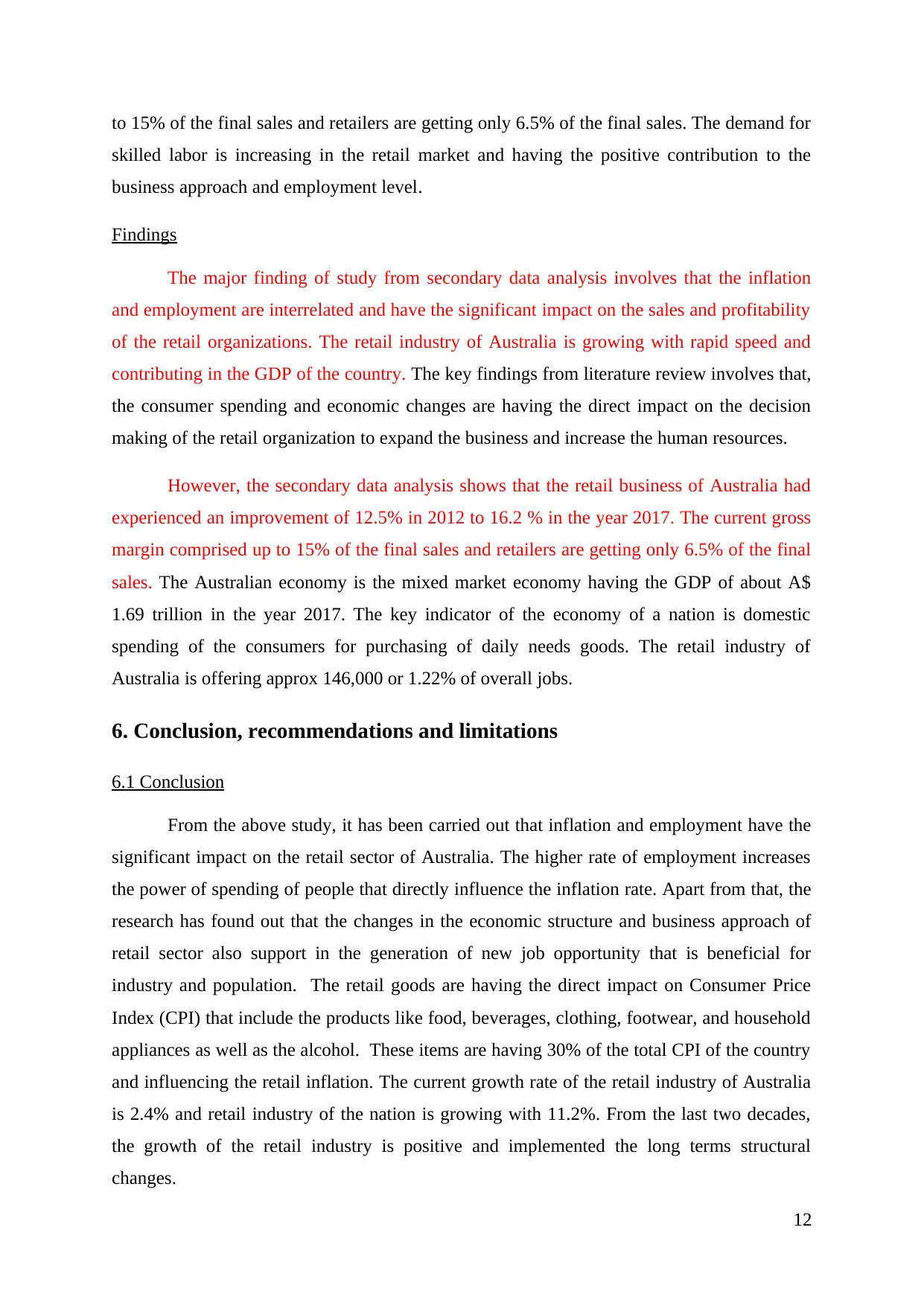
to 15% of the final sales and retailers are getting only 6.5% of the final sales. The demand for
skilled labor is increasing in the retail market and having the positive contribution to the
business approach and employment level.
Findings
The major finding of study from secondary data analysis involves that the inflation
and employment are interrelated and have the significant impact on the sales and profitability
of the retail organizations. The retail industry of Australia is growing with rapid speed and
contributing in the GDP of the country. The key findings from literature review involves that,
the consumer spending and economic changes are having the direct impact on the decision
making of the retail organization to expand the business and increase the human resources.
However, the secondary data analysis shows that the retail business of Australia had
experienced an improvement of 12.5% in 2012 to 16.2 % in the year 2017. The current gross
margin comprised up to 15% of the final sales and retailers are getting only 6.5% of the final
sales. The Australian economy is the mixed market economy having the GDP of about A$
1.69 trillion in the year 2017. The key indicator of the economy of a nation is domestic
spending of the consumers for purchasing of daily needs goods. The retail industry of
Australia is offering approx 146,000 or 1.22% of overall jobs.
6. Conclusion, recommendations and limitations
6.1 Conclusion
From the above study, it has been carried out that inflation and employment have the
significant impact on the retail sector of Australia. The higher rate of employment increases
the power of spending of people that directly influence the inflation rate. Apart from that, the
research has found out that the changes in the economic structure and business approach of
retail sector also support in the generation of new job opportunity that is beneficial for
industry and population. The retail goods are having the direct impact on Consumer Price
Index (CPI) that include the products like food, beverages, clothing, footwear, and household
appliances as well as the alcohol. These items are having 30% of the total CPI of the country
and influencing the retail inflation. The current growth rate of the retail industry of Australia
is 2.4% and retail industry of the nation is growing with 11.2%. From the last two decades,
the growth of the retail industry is positive and implemented the long terms structural
changes.
12
skilled labor is increasing in the retail market and having the positive contribution to the
business approach and employment level.
Findings
The major finding of study from secondary data analysis involves that the inflation
and employment are interrelated and have the significant impact on the sales and profitability
of the retail organizations. The retail industry of Australia is growing with rapid speed and
contributing in the GDP of the country. The key findings from literature review involves that,
the consumer spending and economic changes are having the direct impact on the decision
making of the retail organization to expand the business and increase the human resources.
However, the secondary data analysis shows that the retail business of Australia had
experienced an improvement of 12.5% in 2012 to 16.2 % in the year 2017. The current gross
margin comprised up to 15% of the final sales and retailers are getting only 6.5% of the final
sales. The Australian economy is the mixed market economy having the GDP of about A$
1.69 trillion in the year 2017. The key indicator of the economy of a nation is domestic
spending of the consumers for purchasing of daily needs goods. The retail industry of
Australia is offering approx 146,000 or 1.22% of overall jobs.
6. Conclusion, recommendations and limitations
6.1 Conclusion
From the above study, it has been carried out that inflation and employment have the
significant impact on the retail sector of Australia. The higher rate of employment increases
the power of spending of people that directly influence the inflation rate. Apart from that, the
research has found out that the changes in the economic structure and business approach of
retail sector also support in the generation of new job opportunity that is beneficial for
industry and population. The retail goods are having the direct impact on Consumer Price
Index (CPI) that include the products like food, beverages, clothing, footwear, and household
appliances as well as the alcohol. These items are having 30% of the total CPI of the country
and influencing the retail inflation. The current growth rate of the retail industry of Australia
is 2.4% and retail industry of the nation is growing with 11.2%. From the last two decades,
the growth of the retail industry is positive and implemented the long terms structural
changes.
12
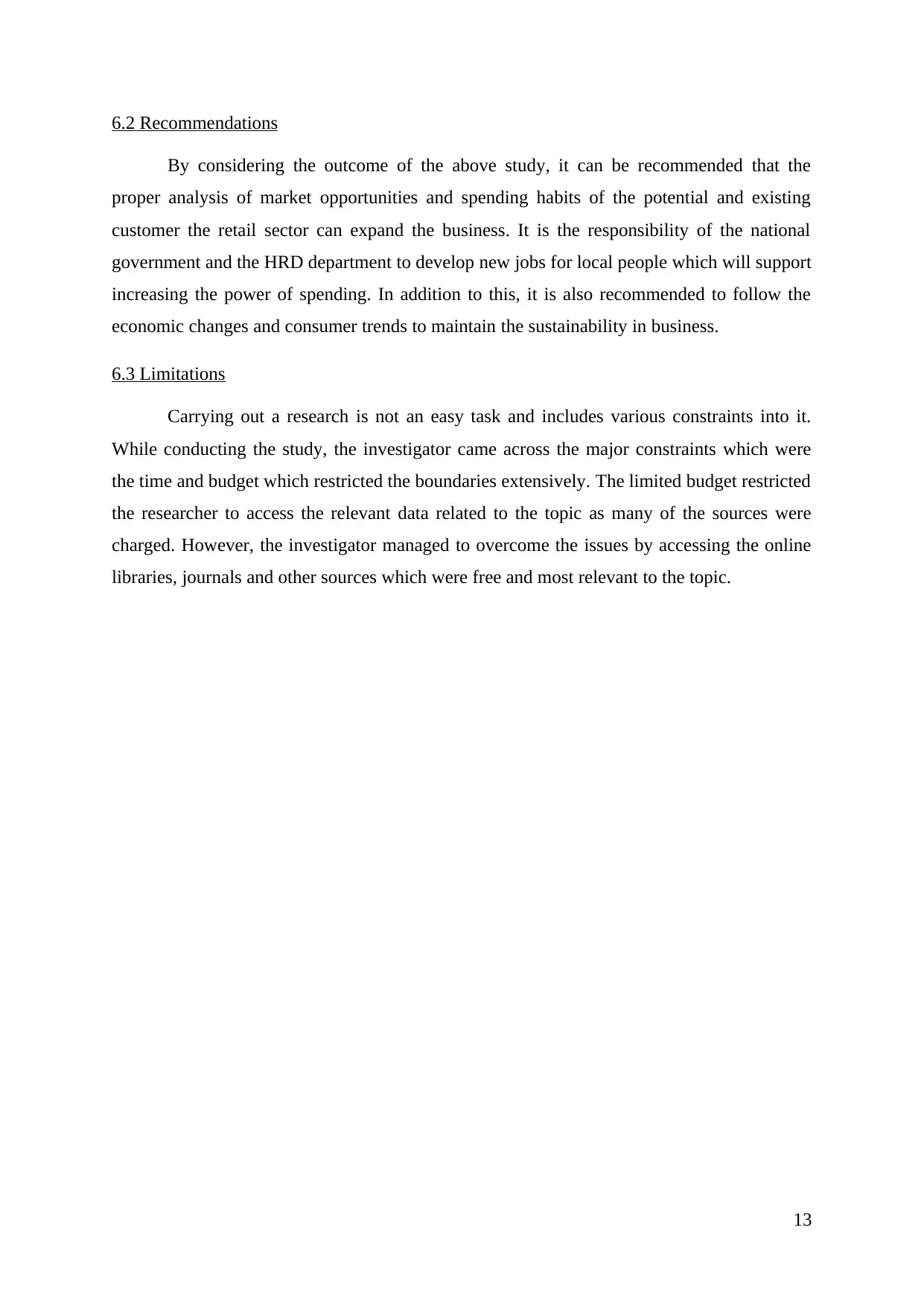
6.2 Recommendations
By considering the outcome of the above study, it can be recommended that the
proper analysis of market opportunities and spending habits of the potential and existing
customer the retail sector can expand the business. It is the responsibility of the national
government and the HRD department to develop new jobs for local people which will support
increasing the power of spending. In addition to this, it is also recommended to follow the
economic changes and consumer trends to maintain the sustainability in business.
6.3 Limitations
Carrying out a research is not an easy task and includes various constraints into it.
While conducting the study, the investigator came across the major constraints which were
the time and budget which restricted the boundaries extensively. The limited budget restricted
the researcher to access the relevant data related to the topic as many of the sources were
charged. However, the investigator managed to overcome the issues by accessing the online
libraries, journals and other sources which were free and most relevant to the topic.
13
By considering the outcome of the above study, it can be recommended that the
proper analysis of market opportunities and spending habits of the potential and existing
customer the retail sector can expand the business. It is the responsibility of the national
government and the HRD department to develop new jobs for local people which will support
increasing the power of spending. In addition to this, it is also recommended to follow the
economic changes and consumer trends to maintain the sustainability in business.
6.3 Limitations
Carrying out a research is not an easy task and includes various constraints into it.
While conducting the study, the investigator came across the major constraints which were
the time and budget which restricted the boundaries extensively. The limited budget restricted
the researcher to access the relevant data related to the topic as many of the sources were
charged. However, the investigator managed to overcome the issues by accessing the online
libraries, journals and other sources which were free and most relevant to the topic.
13
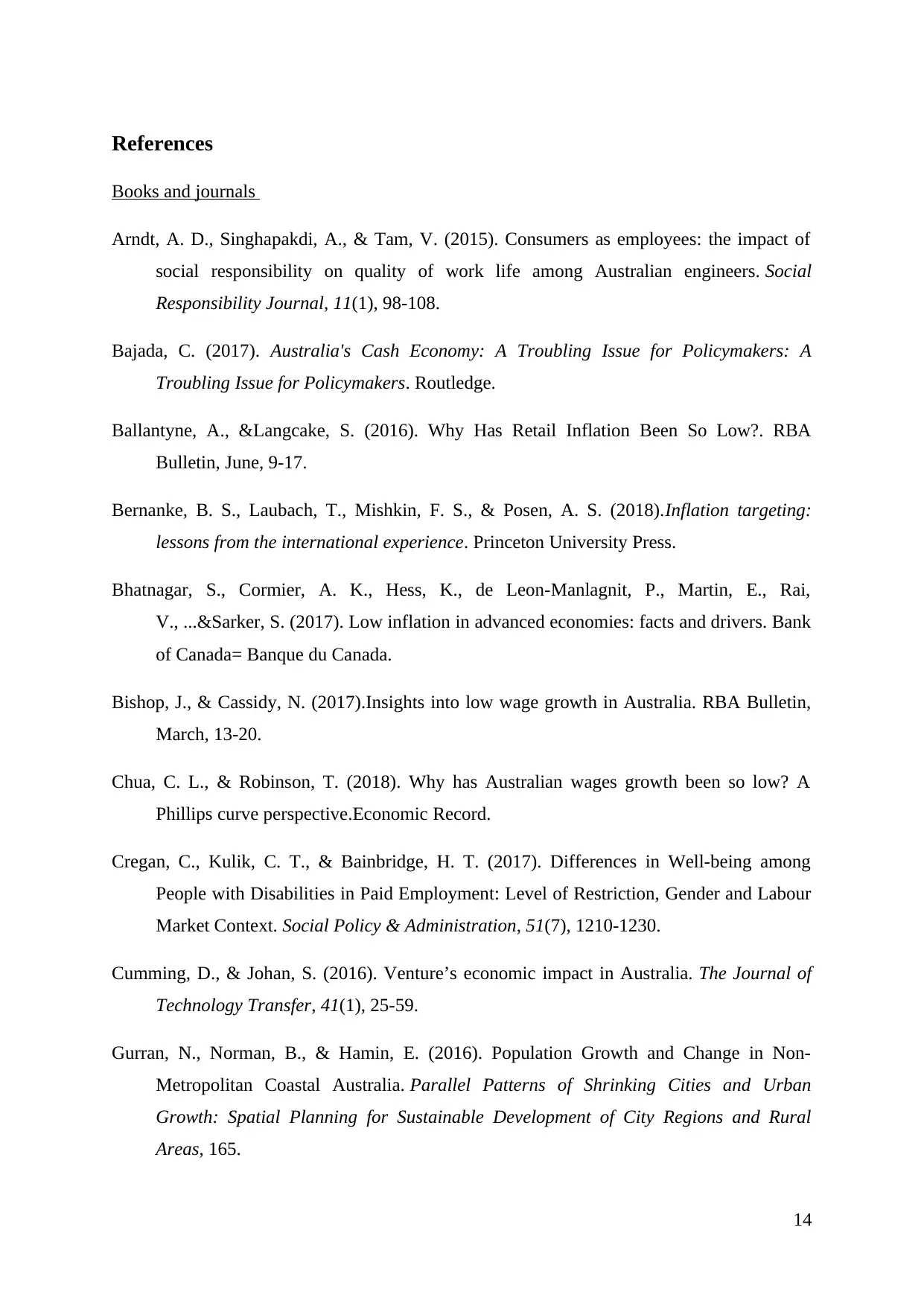
References
Books and journals
Arndt, A. D., Singhapakdi, A., & Tam, V. (2015). Consumers as employees: the impact of
social responsibility on quality of work life among Australian engineers. Social
Responsibility Journal, 11(1), 98-108.
Bajada, C. (2017). Australia's Cash Economy: A Troubling Issue for Policymakers: A
Troubling Issue for Policymakers. Routledge.
Ballantyne, A., &Langcake, S. (2016). Why Has Retail Inflation Been So Low?. RBA
Bulletin, June, 9-17.
Bernanke, B. S., Laubach, T., Mishkin, F. S., & Posen, A. S. (2018).Inflation targeting:
lessons from the international experience. Princeton University Press.
Bhatnagar, S., Cormier, A. K., Hess, K., de Leon-Manlagnit, P., Martin, E., Rai,
V., ...&Sarker, S. (2017). Low inflation in advanced economies: facts and drivers. Bank
of Canada= Banque du Canada.
Bishop, J., & Cassidy, N. (2017).Insights into low wage growth in Australia. RBA Bulletin,
March, 13-20.
Chua, C. L., & Robinson, T. (2018). Why has Australian wages growth been so low? A
Phillips curve perspective.Economic Record.
Cregan, C., Kulik, C. T., & Bainbridge, H. T. (2017). Differences in Well‐being among
People with Disabilities in Paid Employment: Level of Restriction, Gender and Labour
Market Context. Social Policy & Administration, 51(7), 1210-1230.
Cumming, D., & Johan, S. (2016). Venture’s economic impact in Australia. The Journal of
Technology Transfer, 41(1), 25-59.
Gurran, N., Norman, B., & Hamin, E. (2016). Population Growth and Change in Non-
Metropolitan Coastal Australia. Parallel Patterns of Shrinking Cities and Urban
Growth: Spatial Planning for Sustainable Development of City Regions and Rural
Areas, 165.
14
Books and journals
Arndt, A. D., Singhapakdi, A., & Tam, V. (2015). Consumers as employees: the impact of
social responsibility on quality of work life among Australian engineers. Social
Responsibility Journal, 11(1), 98-108.
Bajada, C. (2017). Australia's Cash Economy: A Troubling Issue for Policymakers: A
Troubling Issue for Policymakers. Routledge.
Ballantyne, A., &Langcake, S. (2016). Why Has Retail Inflation Been So Low?. RBA
Bulletin, June, 9-17.
Bernanke, B. S., Laubach, T., Mishkin, F. S., & Posen, A. S. (2018).Inflation targeting:
lessons from the international experience. Princeton University Press.
Bhatnagar, S., Cormier, A. K., Hess, K., de Leon-Manlagnit, P., Martin, E., Rai,
V., ...&Sarker, S. (2017). Low inflation in advanced economies: facts and drivers. Bank
of Canada= Banque du Canada.
Bishop, J., & Cassidy, N. (2017).Insights into low wage growth in Australia. RBA Bulletin,
March, 13-20.
Chua, C. L., & Robinson, T. (2018). Why has Australian wages growth been so low? A
Phillips curve perspective.Economic Record.
Cregan, C., Kulik, C. T., & Bainbridge, H. T. (2017). Differences in Well‐being among
People with Disabilities in Paid Employment: Level of Restriction, Gender and Labour
Market Context. Social Policy & Administration, 51(7), 1210-1230.
Cumming, D., & Johan, S. (2016). Venture’s economic impact in Australia. The Journal of
Technology Transfer, 41(1), 25-59.
Gurran, N., Norman, B., & Hamin, E. (2016). Population Growth and Change in Non-
Metropolitan Coastal Australia. Parallel Patterns of Shrinking Cities and Urban
Growth: Spatial Planning for Sustainable Development of City Regions and Rural
Areas, 165.
14
Paraphrase This Document
Need a fresh take? Get an instant paraphrase of this document with our AI Paraphraser
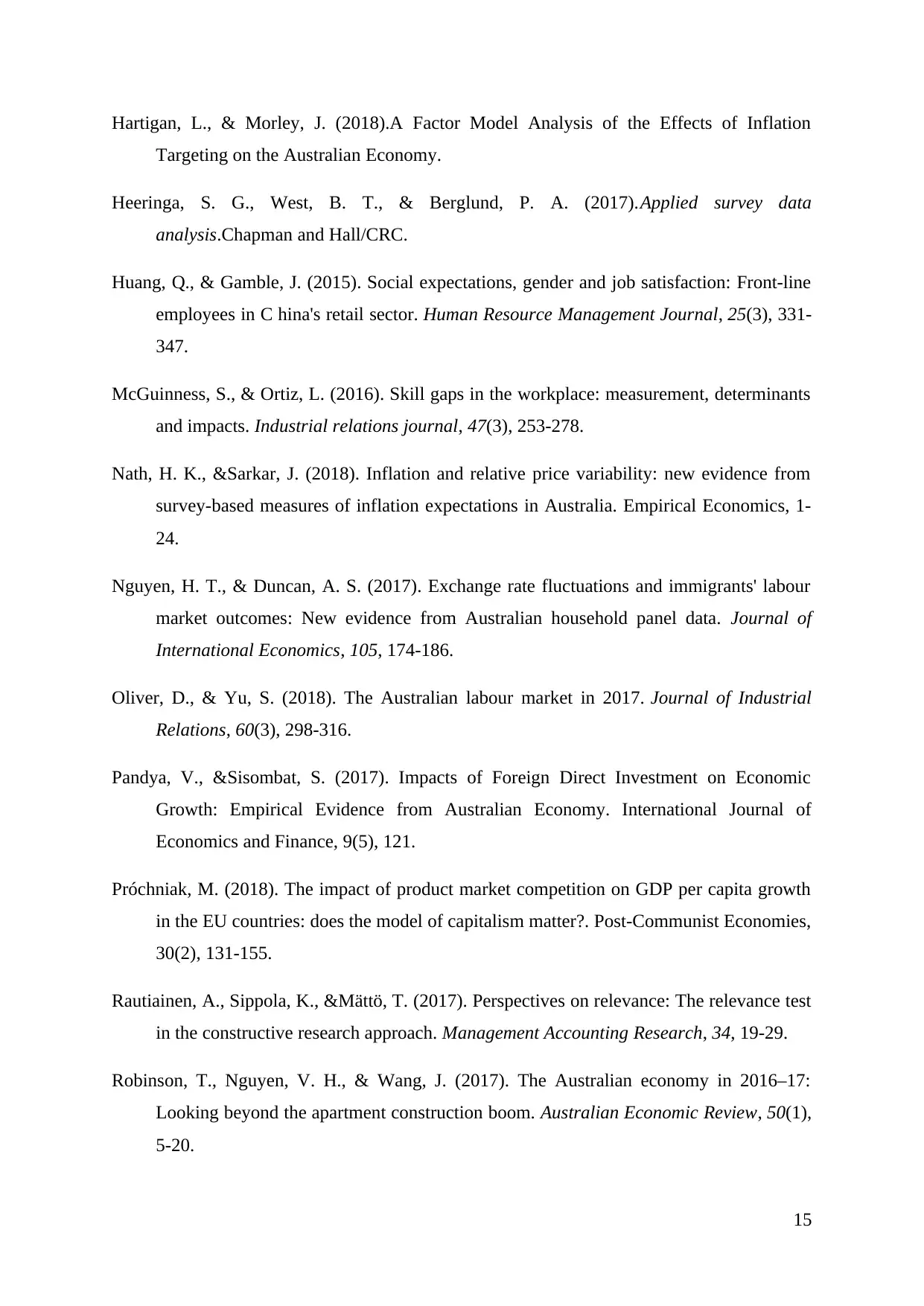
Hartigan, L., & Morley, J. (2018).A Factor Model Analysis of the Effects of Inflation
Targeting on the Australian Economy.
Heeringa, S. G., West, B. T., & Berglund, P. A. (2017).Applied survey data
analysis.Chapman and Hall/CRC.
Huang, Q., & Gamble, J. (2015). Social expectations, gender and job satisfaction: Front‐line
employees in C hina's retail sector. Human Resource Management Journal, 25(3), 331-
347.
McGuinness, S., & Ortiz, L. (2016). Skill gaps in the workplace: measurement, determinants
and impacts. Industrial relations journal, 47(3), 253-278.
Nath, H. K., &Sarkar, J. (2018). Inflation and relative price variability: new evidence from
survey-based measures of inflation expectations in Australia. Empirical Economics, 1-
24.
Nguyen, H. T., & Duncan, A. S. (2017). Exchange rate fluctuations and immigrants' labour
market outcomes: New evidence from Australian household panel data. Journal of
International Economics, 105, 174-186.
Oliver, D., & Yu, S. (2018). The Australian labour market in 2017. Journal of Industrial
Relations, 60(3), 298-316.
Pandya, V., &Sisombat, S. (2017). Impacts of Foreign Direct Investment on Economic
Growth: Empirical Evidence from Australian Economy. International Journal of
Economics and Finance, 9(5), 121.
Próchniak, M. (2018). The impact of product market competition on GDP per capita growth
in the EU countries: does the model of capitalism matter?. Post-Communist Economies,
30(2), 131-155.
Rautiainen, A., Sippola, K., &Mättö, T. (2017). Perspectives on relevance: The relevance test
in the constructive research approach. Management Accounting Research, 34, 19-29.
Robinson, T., Nguyen, V. H., & Wang, J. (2017). The Australian economy in 2016–17:
Looking beyond the apartment construction boom. Australian Economic Review, 50(1),
5-20.
15
Targeting on the Australian Economy.
Heeringa, S. G., West, B. T., & Berglund, P. A. (2017).Applied survey data
analysis.Chapman and Hall/CRC.
Huang, Q., & Gamble, J. (2015). Social expectations, gender and job satisfaction: Front‐line
employees in C hina's retail sector. Human Resource Management Journal, 25(3), 331-
347.
McGuinness, S., & Ortiz, L. (2016). Skill gaps in the workplace: measurement, determinants
and impacts. Industrial relations journal, 47(3), 253-278.
Nath, H. K., &Sarkar, J. (2018). Inflation and relative price variability: new evidence from
survey-based measures of inflation expectations in Australia. Empirical Economics, 1-
24.
Nguyen, H. T., & Duncan, A. S. (2017). Exchange rate fluctuations and immigrants' labour
market outcomes: New evidence from Australian household panel data. Journal of
International Economics, 105, 174-186.
Oliver, D., & Yu, S. (2018). The Australian labour market in 2017. Journal of Industrial
Relations, 60(3), 298-316.
Pandya, V., &Sisombat, S. (2017). Impacts of Foreign Direct Investment on Economic
Growth: Empirical Evidence from Australian Economy. International Journal of
Economics and Finance, 9(5), 121.
Próchniak, M. (2018). The impact of product market competition on GDP per capita growth
in the EU countries: does the model of capitalism matter?. Post-Communist Economies,
30(2), 131-155.
Rautiainen, A., Sippola, K., &Mättö, T. (2017). Perspectives on relevance: The relevance test
in the constructive research approach. Management Accounting Research, 34, 19-29.
Robinson, T., Nguyen, V. H., & Wang, J. (2017). The Australian economy in 2016–17:
Looking beyond the apartment construction boom. Australian Economic Review, 50(1),
5-20.
15
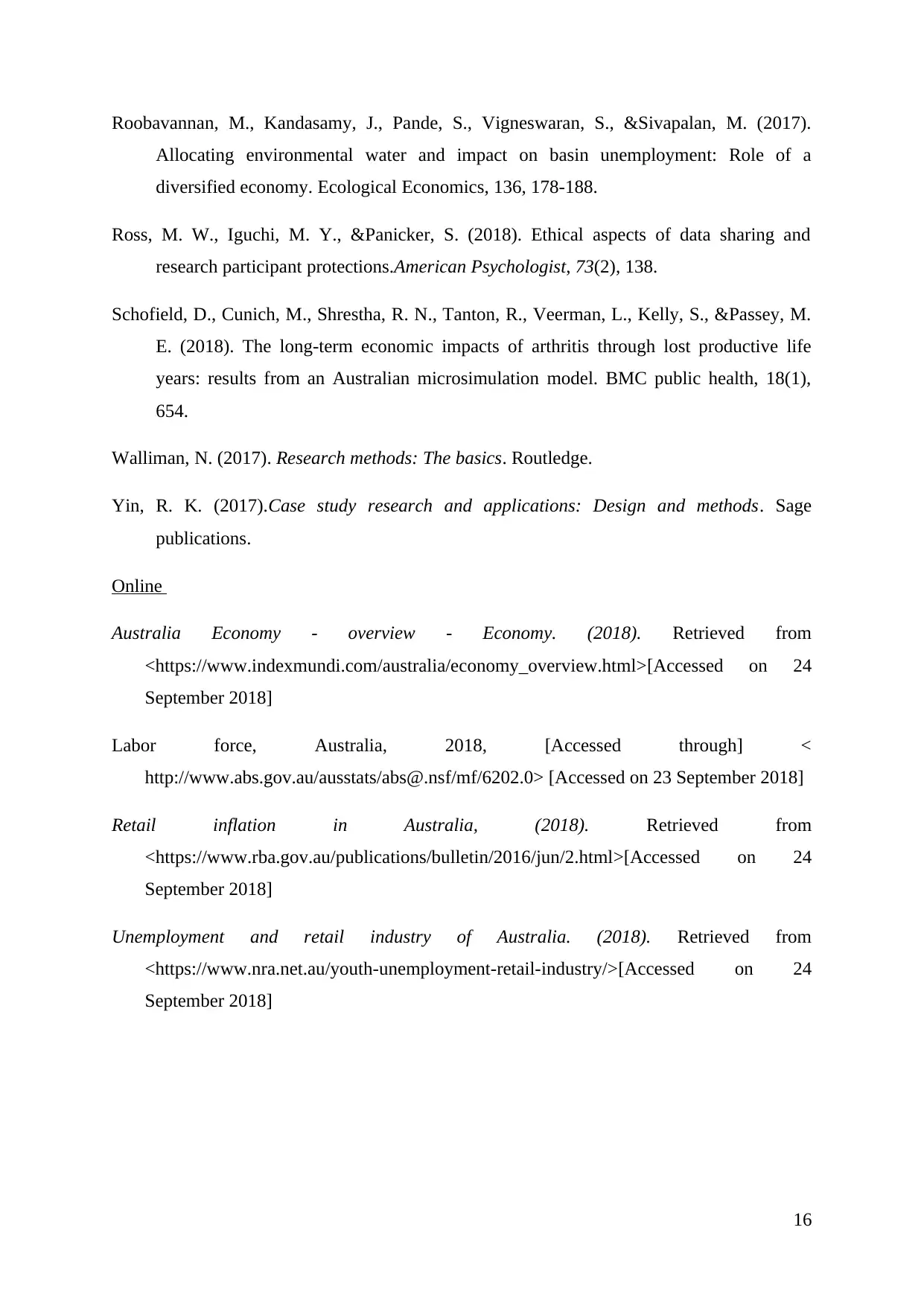
Roobavannan, M., Kandasamy, J., Pande, S., Vigneswaran, S., &Sivapalan, M. (2017).
Allocating environmental water and impact on basin unemployment: Role of a
diversified economy. Ecological Economics, 136, 178-188.
Ross, M. W., Iguchi, M. Y., &Panicker, S. (2018). Ethical aspects of data sharing and
research participant protections.American Psychologist, 73(2), 138.
Schofield, D., Cunich, M., Shrestha, R. N., Tanton, R., Veerman, L., Kelly, S., &Passey, M.
E. (2018). The long-term economic impacts of arthritis through lost productive life
years: results from an Australian microsimulation model. BMC public health, 18(1),
654.
Walliman, N. (2017). Research methods: The basics. Routledge.
Yin, R. K. (2017).Case study research and applications: Design and methods. Sage
publications.
Online
Australia Economy - overview - Economy. (2018). Retrieved from
<https://www.indexmundi.com/australia/economy_overview.html>[Accessed on 24
September 2018]
Labor force, Australia, 2018, [Accessed through] <
http://www.abs.gov.au/ausstats/abs@.nsf/mf/6202.0> [Accessed on 23 September 2018]
Retail inflation in Australia, (2018). Retrieved from
<https://www.rba.gov.au/publications/bulletin/2016/jun/2.html>[Accessed on 24
September 2018]
Unemployment and retail industry of Australia. (2018). Retrieved from
<https://www.nra.net.au/youth-unemployment-retail-industry/>[Accessed on 24
September 2018]
16
Allocating environmental water and impact on basin unemployment: Role of a
diversified economy. Ecological Economics, 136, 178-188.
Ross, M. W., Iguchi, M. Y., &Panicker, S. (2018). Ethical aspects of data sharing and
research participant protections.American Psychologist, 73(2), 138.
Schofield, D., Cunich, M., Shrestha, R. N., Tanton, R., Veerman, L., Kelly, S., &Passey, M.
E. (2018). The long-term economic impacts of arthritis through lost productive life
years: results from an Australian microsimulation model. BMC public health, 18(1),
654.
Walliman, N. (2017). Research methods: The basics. Routledge.
Yin, R. K. (2017).Case study research and applications: Design and methods. Sage
publications.
Online
Australia Economy - overview - Economy. (2018). Retrieved from
<https://www.indexmundi.com/australia/economy_overview.html>[Accessed on 24
September 2018]
Labor force, Australia, 2018, [Accessed through] <
http://www.abs.gov.au/ausstats/abs@.nsf/mf/6202.0> [Accessed on 23 September 2018]
Retail inflation in Australia, (2018). Retrieved from
<https://www.rba.gov.au/publications/bulletin/2016/jun/2.html>[Accessed on 24
September 2018]
Unemployment and retail industry of Australia. (2018). Retrieved from
<https://www.nra.net.au/youth-unemployment-retail-industry/>[Accessed on 24
September 2018]
16
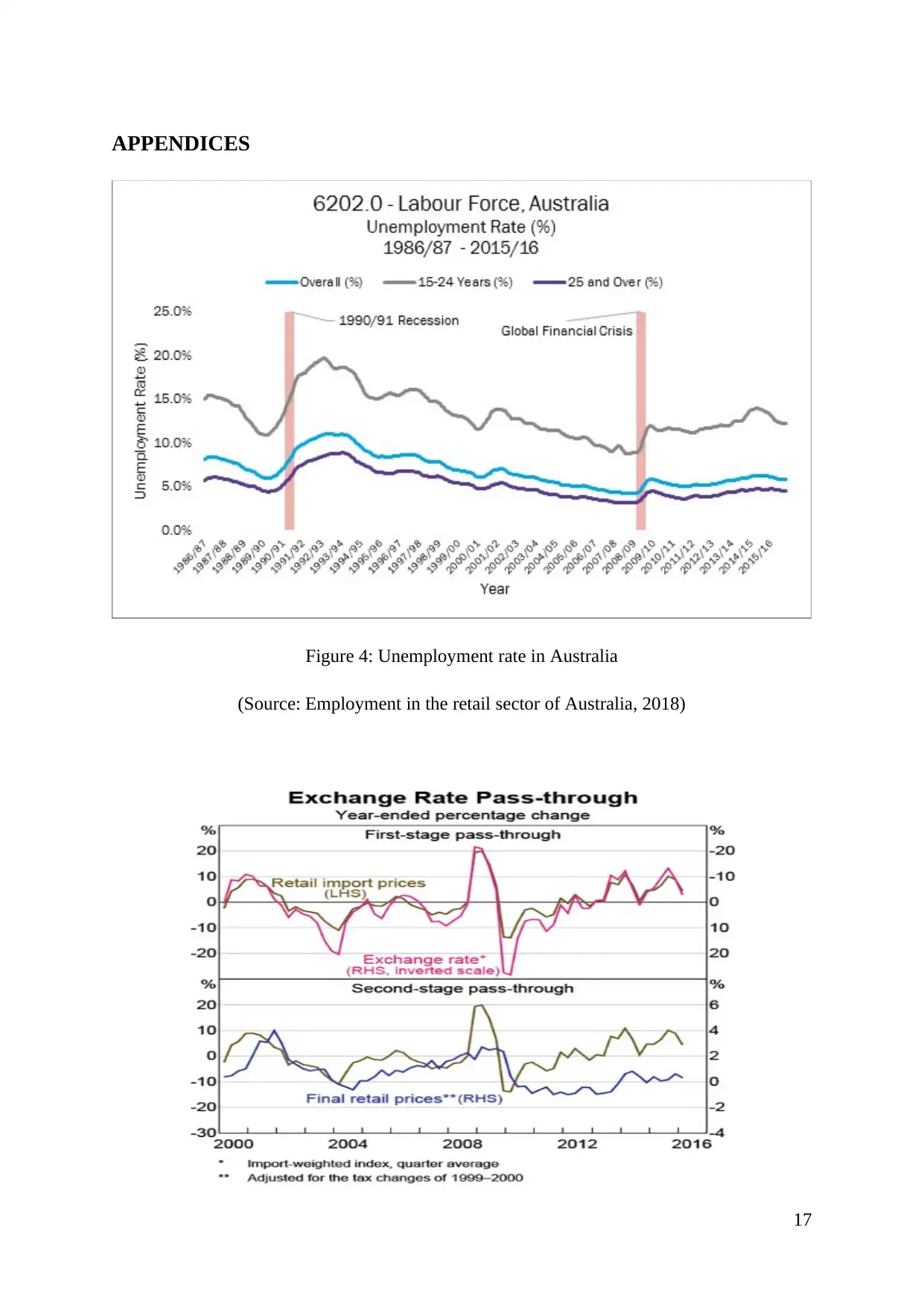
APPENDICES
Figure 4: Unemployment rate in Australia
(Source: Employment in the retail sector of Australia, 2018)
17
Figure 4: Unemployment rate in Australia
(Source: Employment in the retail sector of Australia, 2018)
17
Secure Best Marks with AI Grader
Need help grading? Try our AI Grader for instant feedback on your assignments.
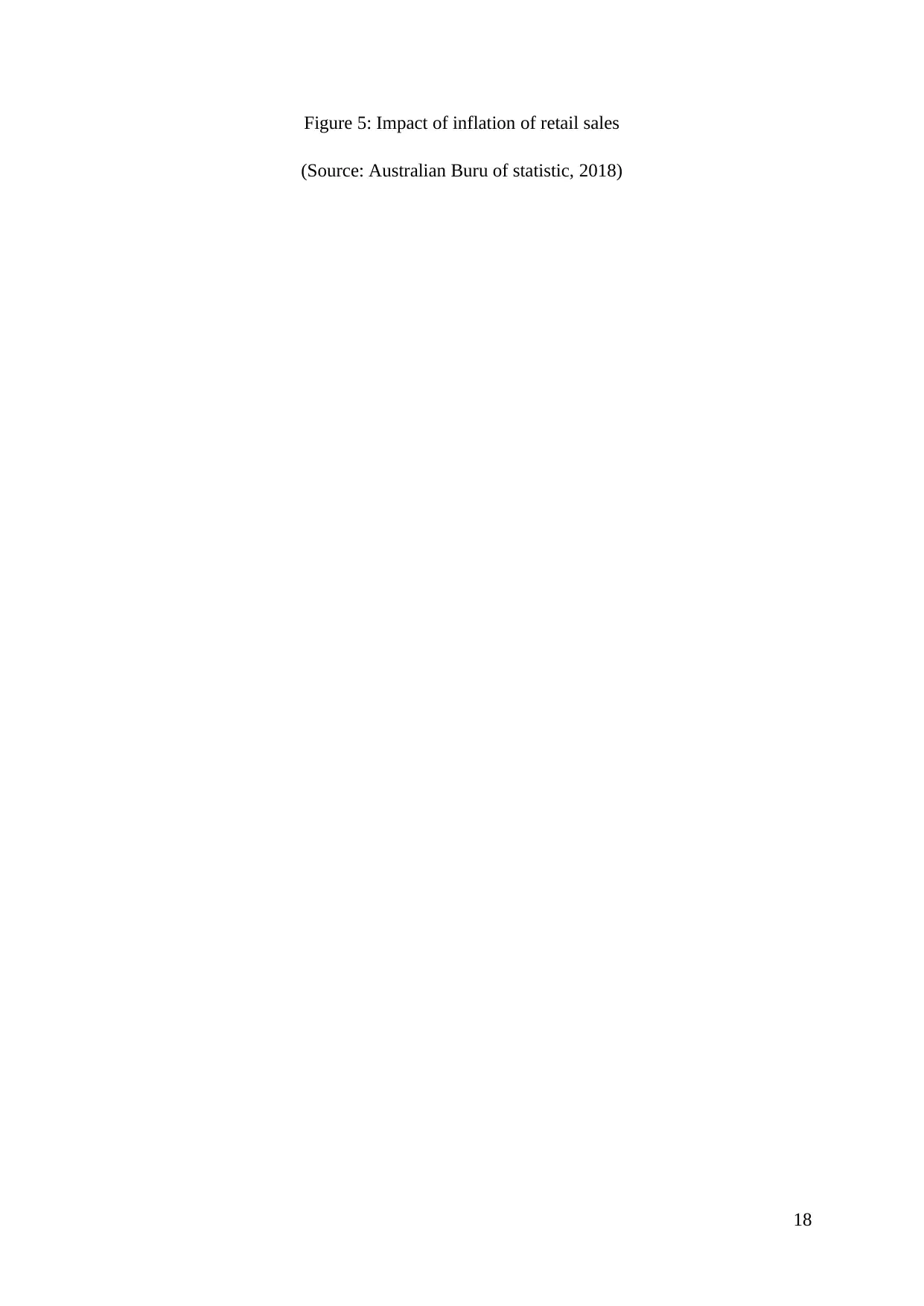
Figure 5: Impact of inflation of retail sales
(Source: Australian Buru of statistic, 2018)
18
(Source: Australian Buru of statistic, 2018)
18
1 out of 23
Related Documents
Your All-in-One AI-Powered Toolkit for Academic Success.
+13062052269
info@desklib.com
Available 24*7 on WhatsApp / Email
![[object Object]](/_next/static/media/star-bottom.7253800d.svg)
Unlock your academic potential
© 2024 | Zucol Services PVT LTD | All rights reserved.





